NUEVA CURRENT THE



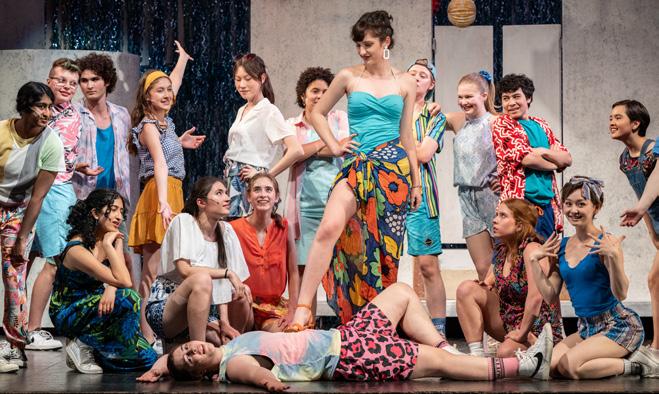
In
and

P 7]
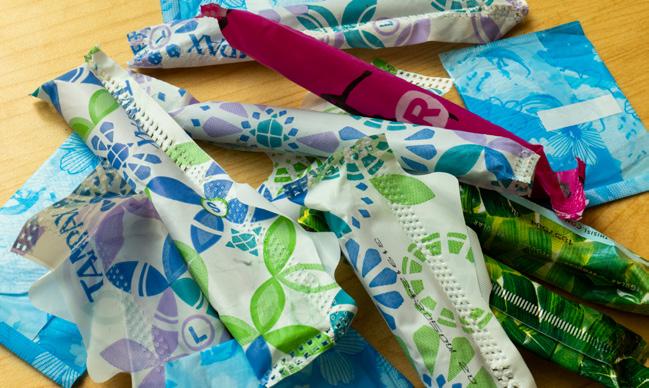
For far too long, female students have conformed to social pressures around menstruation. Kayla L. ’26 calls for an end to stigma around periods. [ P 14 ]
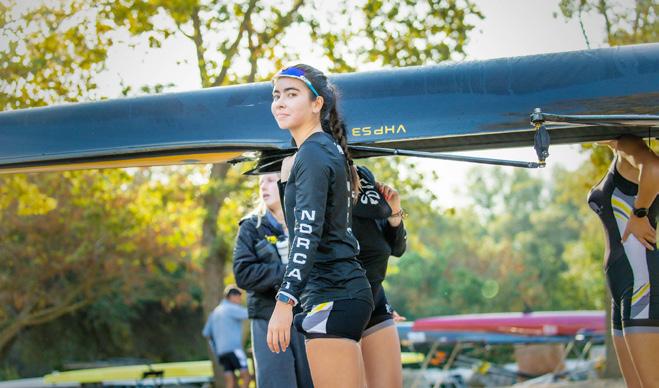
Nationally, a firestorm of debate has surrounded DEI as states introduce legislation to dismantle DEI systems.
By Gabe H.







DEI under threat
“I have a friend in Arizona who was doing fantastic work in middle schools combating racialized and gendered violence,” said Director of Equity and Inclusion Shawn Taylor. “He was told last year that his contract, which ran in three-year cycles, would not be renewed. It has gotten so bad for him in the state that he and his family—his wife does similar work—are considering moving so they can continue their work.”
After years of increased funding and expansion of diversity, equity, and inclusion (DEI) roles and programs in educational institutions and major companies, DEI initiatives are now being paused, scaled back, or dismantled. As legislators and individuals launch legal challenges and complaints against DEI efforts to foster racial equity, a national debate has been ignited around if and how DEI systems should be implemented.
At Nueva, which states that its vision for students is to “enable gifted learners to make choices that benefit the world,” social justice, diversity, equity, and inclusion have long been esteemed values. The message of building a Beloved Community is continually reinforced with day-long events like MLK Day, which offer workshops and presentations that examine various topics through a DEI lens. The value of
“belonging” was named as one of the priorities in the school’s five-year strategic framework.
In principle, DEI is a community practice that fosters diversity, equity, and inclusion in institutions. According to Upper School English & SEL Teacher Pearl Bauer, the ultimate goal of DEI at Nueva is to promote a “sense of belonging in a beloved community.” Taylor, who began his role on May 1, said that DEI’s main emphasis is “taking into account cultural, social, economic, and gender considerations.”
“It's really about what is going to make this particular student as successful as they are, and which barriers as an institution can we remove,” he added.
Public discourse about the efficacy and ethicality of DEI has faced renewed contention in 2023, following the Supreme Court’s decision that overturned raceconscious admissions in higher education.
According to a report by the Chronicle of Higher Education, 85 anti-DEI bills have been introduced since 2023, 14 of which have been granted final legislative approval and another 14 of which have been signed into law by a governor.
These trends prevailed in the new year. In mid-February 2024, Kentucky’s senate passed a bill banning statements of DEI on campuses. On March 1, the University of Florida terminated all positions bearing any
association with DEI, including closing the office of the director and firing 13 full-time workers. An additional 15 employees with DEI appointments saw their roles shuttered.
As legislative backlash to DEI has risen in recent months, the implementation of DEI practices has been on the decline during the last year. Between November 2022 and November 2023, there was a 23 percent downturn in the number of job titles bearing DEI in the description, nearly nullifying previous increases.
With many states poised to strike down educational legislation in the coming months, discourse around DEI has gained momentum, including here on campus.
For Mars R. ’27, race-conscious admissions, one facet of DEI, has been a divisive subject. When they engaged in a conversation with an Asian student about race-conscious admissions in higher education, they did not expect to feel isolated from their peers. The student, who does not go to Nueva, expressed that these admissions policies unfairly privilege Black people at the expense of their Asian counterparts. As a Black student, Mars was taken aback and perturbed.
“I felt like she was accusing me of stealing education and access from her,” Mars said.
[ CONTINUED ON P 10 ]
After 10 months of planning, 18 Wednesday of Wonder (WoW) workshops entirely dedicated to Earth Day took place on April 24, including environmental magazines, recycled yarn crocheting, and many other workshops.
“We wish that when everyone was signing up for these WoWs, they were scrolling through the variety of topics and see the different opportunities,” said Alex W. ’24, co-lead of the Environmental Club. “I hope people now fully realize what's going on with our environment and internalize that.”
For their Earth Day WoW, Natasha M. ’27 and Zoe C. ’27 led a field trip to Wildtype, a company using cells
to create lab-grown seafood. They took over 25 students on a tour of Wildtype’s production to learn how they made salmon to solve the destruction caused by fishing.
“It is so inspiring to see an idea turn into a start-up,” said Natasha. “I feel like Nueva provides that spark for people's interests by allowing us to hold these WoWs that let us share and explore what we are passionate about.”
Back on campus, Kayla L. ’26 and Julia C. ’27 held a plant-based cooking WoW. The menu consisted of fried tofu sticks, chocolate mousse, and banana foster chia seed pudding.
“Being able to teach other people these recipes and give them ways to make small changes is the important thing that can benefit the environment,” Julia said.
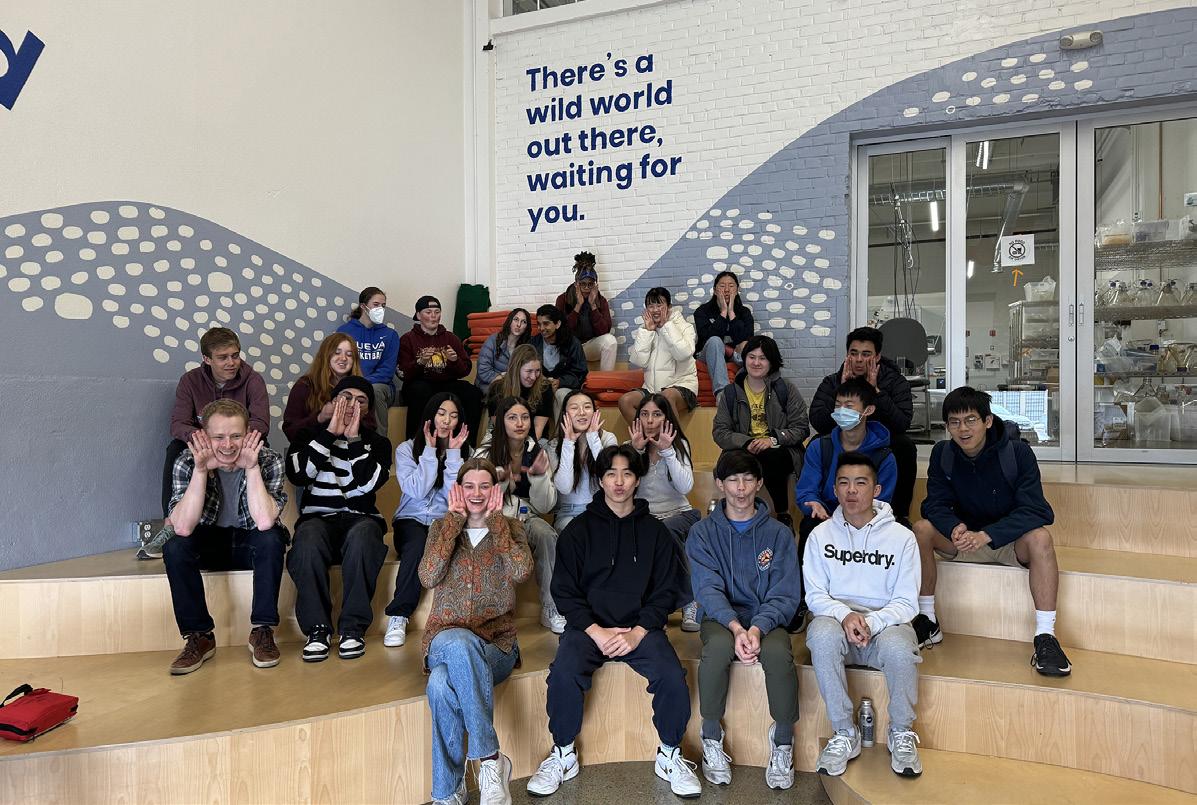
After the WoWs were over, the Environmental Club leaders shared more about the WoWs, highlighting that unlike in the past, they wanted to focus on interactive WoWs to engage students with the environment.
“We hoped these WoWs could allow both our club members and our community to step up and explore their passions for a longer period of time,” said Naomie C. ’24, another leader of the Environmental Club.
“Many of the WoWs were led by underclassmen,” Naomie added. “I feel like creating opportunities for our next generation of environmental leaders pushes them to step up.”
Kayla, co-lead of the Environmental Club, shared the need for forward thinking towards the environmental crisis in the face of climate doomism, the idea that mankind is likely to go extinct and there is nothing we can do about global warming.
“There is hope and there are solutions,” Kayla said. “We tried our best to engage people in the workshops so that they felt like they were doing something tangible to help.”
Students visiting lab-grown salmon company make fish faces while waiting for their tour.

distributed in the Eid celebration organized by the Muslim Student Association and South Asian Affinity Group gulab jamuns

ran for Student Council for the 20242025 school year—all positions except for the incoming 9th grade representatives candidates
Inaugural event fosters cultural exchange through traditional games, culinary delights, and assemblies
By Ellie L.The inaugural World Cultures Day took place at the Upper School on May 1, featuring cultural Wednesdays of Wonder Workshops (WOWs), traditional food booths, and foreign-language assemblies. Coinciding with Dress As Your Culture Spirit Day, many students, inspired by the two events, wore a variety of cultural garments, including qipaos, kimonos, and saris.
In the morning, students attended a variety of WOWs where they learned how to play traditional games such as mahjong and carreras americanas, cultural films provided by language teachers, and made foods—from lumpia with the Filipino Affinity Space to quesadillas with the Latine Affinity Group.
During the afternoon, language teachers introduced various traditions and songs in school-wide assemblies. In one such assembly led by the Chinese teachers, Cameron L. ’27, co-lead of the Taiwanese Affinity Group, sang with

a Taiwanese senior choir, alongside other Taiwanese students, and found a “sense of family.”
Following the cultural assemblies, students exited the gym to multiple tables set up with homemade posters about different
countries’ and food from their cuisines.
“We got to appreciate our differences,” Cameron said of the fair.
At one table, some students ate alfajores, traditional dulce de leche sandwich cookies; at another, some played ddakji, a
Students chase each other and laugh as they play carreras americanas, a Mexican game where students hold hands in duos and chase each other around in a race to get back to their spots in the circle. Becerra-Hernandez led the game in one of the cultural WOWs in the morning.
Korean game.
Jules S. ’26, co-lead of the Korean Affinity Group, noted the surprising amount of student engagement with the ddakji table.
“Everyone was so genuinely interested,” said Jules. “It was cool to see people connect with my culture.”
Spanish teacher Francisco BecerraHernandez, one of the organizers of the day’s festivities, noted the “power” in student engagement during each event.
As for the future, Becerra-Hernandez envisions even more engagement and opportunities for all community members.
“It’ll be a good tradition,” BecerraHernandez said.
Starting next year, school to cover full cost of tuition for families making less than $150,000 annually
By Jackson H.Starting in the 2024–25 school year, Nueva will introduce a significant expansion to its financial assistance program as part of a broader effort to increase socioeconomic diversity at the school.
For households earning less than $150,000 a year, Nueva will cover the full cost of tuition in addition to all other costs associated with attending Nueva, such as for transport or extracurriculars. Additionally, households earning $150,000 to $250,000 annually will contribute between 1 and 10 percent of their income towards tuition.
In the letter announcing this news and jointly signed by Head of School Lee
Fertig and Board Co-Chairs Hoon Cho and Kathleen Donohue, the authors shared, “In March, the Board of Trustees unanimously and enthusiastically endorsed a new financial assistance policy that we believe is a landmark step for our school.”
Discussions for the new changes began in the aftermath of last year’s community survey, which highlighted the desire for increased socioeconomic diversity.
“It was one of the key pieces that everyone from students, to parents, to faculty members, to alumni, wanted to see changed,” said Melanie León, Director of Admissions.
The school determined that increasing accessibility was a key part of any push for economic diversity. Research has found
that the most common dropoff point for colleges and independent high schools’ websites was the page showing tuition. In finding a solution, the admissions team drew inspiration from existing college programs.
On April 5, the policy was announced to the faculty and staff during Professional Development Day and received enthusiastic support.
“I’ve had a lot of faculty or staff approach me or send me emails about how excited they are about this,” León said. “I think it's going to bring a lot of pride and joy to our community as a whole, which is amazing.”
In addition to the tuition changes, Nueva will increase its outreach to underserved communities in the Bay Area, including
communication with local junior high schools about the policy changes and providing access to Nueva Summer for long-standing partners like Peninsula Bridge, a local nonprofit that provides extracurricular and academic support for low-income students. Outreach aims to address the perceptions of Nueva as financially gated.
“When families first apply for independent schools, they worry about the privilege they think might be in the community, and they're worried there won’t be a sense of belonging,” León said. “With this initiative, our hope and our expectation is that they will see that there is a path to Nueva.”
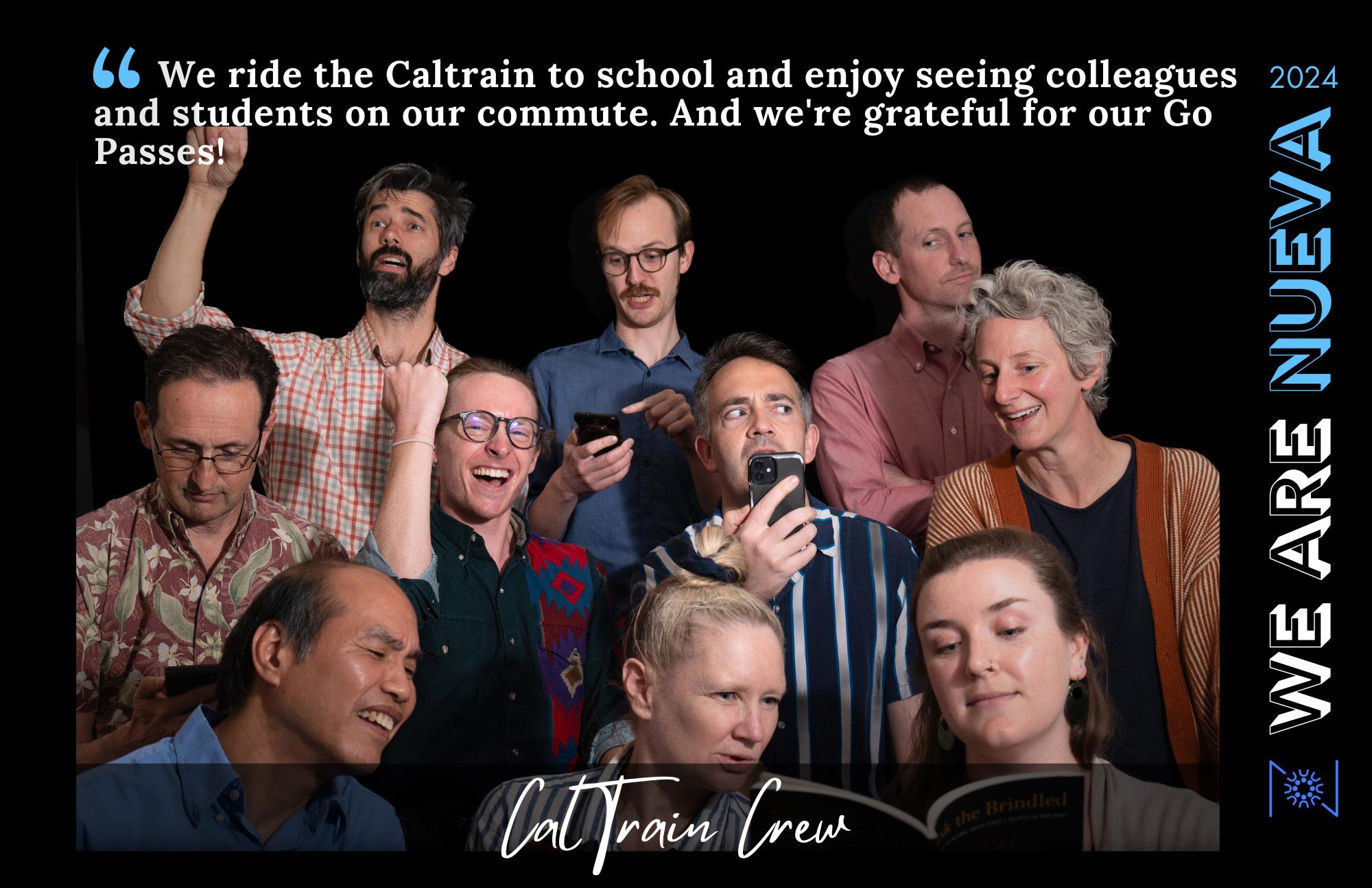

Subhead: Nueva sophomores create community-based photo installation
Students arrived on campus on May 29 to find a campus art installation of candid photographs featuring their friends, classmates, and teachers.
This was the “We Are Nueva” photography project, led by photographer Kayla L. ’26 and visual artist Rachel Y. ’26.
“We Are Nueva” is a school-wide portrait-style photo exhibit—featuring over 100 people—that highlights different racial and social groups within the Nueva community, such as the Persian Affinity Group, Christian Affinity Group, and a group of teachers that take Caltrain
together every morning.
Claire Yeo, Nueva’s Upper School Assistant Division Head, commissioned this photo project at the beginning of the semester as a commemoration of the Upper School campus’ tenth anniversary.
Yeo first recruited Kayla because of her experience in school-based photography, citing her unique style and dramatic staging in post-production.
“I love [Kayla's] artistry in capturing people,” Yeo said. “She makes them look like subjects in a Caravaggio painting— with strong darks and lights and people making dramatic gestures. I'm delighted that she has donated her photography gifts to this project.”
Kayla then brought in Rachel, who helped design the print layout and
managed the logistics of printing each piece.
The two students have found value in interacting with all the people who participate, whether they’re faculty, staff, or students.
At the beginning of each photoshoot, Kayla asked each participant two questions: “What brings you together?” and “What do you love about Nueva?”
Kayla found their quotes moving, thought-provoking, and inspiring. For example, the language teachers described themselves as windows to global cultures, bringing the world closer to Nueva’s students.
“They bring so much culture and knowledge to the school,” Kayla said. “Having them as teachers is so
Following a controversial recount, Evan Low beats Joe Simitian to get on the November ballot
By Jackson H.The primary for California’s 16th congressional district—including the San Mateo county coast, the Lower Peninsula, and southern San Jose—concluded on May 2 with Democrats Sam Liccardo and Evan Low advancing to the general election in November.
The final result comes after two months of uncertainty, as the initial tally yielded an unprecedented result—a tie.
The first count took place over multiple weeks, eventually giving Assembly member Evan Low and Santa Clara County Supervisor Joe Simitian 30,249 votes each, tied for second place behind former San Jose mayor
closed the gap. Once the recount concluded, Low came out with a five-votes lead over Simitian, amounting to an underdog victory.
The recount was not without its fair share of controversy.
California administers a recount only when one voter requests and pays for it. Absent one of those requests, Liccardo, Low, and Simitian would all have advanced for the general election.
That’s because California uses a “jungle primary” system, wherein candidates from all parties are listed on the same primary ballot, and the two with the most votes advance to the general election. The system, in a safe state like California,

Low campaign attacked the connection between Padilla and Liccardo, arguing that the recount had been covertly backed by the former mayor.
But in the end, the recount worked out to Low’s benefit. This set up a two-horse race, where there are only two candidates with a chance of winning, for November. While the general election is still a ways away, the contrast between the two campaigns has already presented itself: Low’s primary focus lies on socially progressive issues, such as reproductive health and Stop Asian Hate, while Liccardo’s platform centers on homelessness, public safety, and the cost of living.
The highly competitive primary came as a result of Democrat Anna Eshoo’s retirement after representing the district for 31 years. Whoever replaces her will likely have a lock on the seat until they choose to retire.
The three major Democratic candidates for California's 16th district.
From left to right: Evan Low, State Assemblymember from Capmbell (2014–present); Sam Liccardo, Mayor of San Jose (2015–2023); Joe Simitian, Member of Santa Clara County Board of Supervisors from Palo Alto (2013–present).
empowering and it made me reflect on my experience here at Nueva.”
Moreover, Kayla enjoyed learning about the friend groups among teachers. One group calls themselves “Casa Roya”, and consists of math teacher Roya Curtis, Dani Moseley, Paul Hicks, and several others. Another group is the I-Lab teachers, who all wore matching overalls for their photoshoot.
Kayla echoed Rachel’s sentiment, expressing her hopes for the positive impact this project will have on the Upper School.
“We hoped to highlight and celebrate our community by bringing everyone together through this collection of portraits,” Rachel said.
Evan Low shares his journey into politics and the importance of young voter turnout
By Jackson H.California Assemblymember and congressional candidate Evan Low visited the Upper School on May 30 as a guest speaker to discuss his background and the importance of increasing youth voter turnout.
When first elected to the Assembly in 2014, Low became the youngest gay Asian-American legislator ever elected to the Assembly. He has spent the ten years since as one of the more prolific legislators in Sacramento.
At the Upper School, Low stressed that young people aged 18 to 29 ought to engage in the political system.
“What are you going to do to exercise your right to hold people like me accountable?” Low asked, urging students in attendance to vote if they were of age. “If we had greater turnout for young voters, we may see elected officials or politicians look like you, share your lived experiences, and address issues that impact you.”
Low cited his own background as an unlikely path to engagement. He recounted being indifferent towards politics until his time in community college when he attended city council meetings and realized the importance of governance. Ultimately, he decided to pursue a career in government.
“I’m an introvert. I don’t think of myself as a good speaker. But the truth is, you do not have the luxury of not being involved,” Low said.
He further argued in favor of reforms such as making Election Day a national holiday and increasing civics education in schools, both of which he had previously advocated for in the State Assembly. He also noted
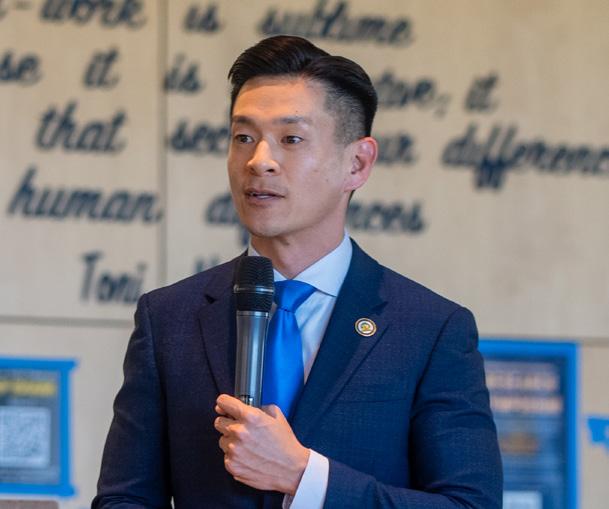
existing legislation on automatic voter registration and absentee ballots that make the minutiae of casting a ballot easier for first-time voters.
In addition to his focus on engaging young voters, Low spoke at length about marriage equality. He pointed to an amendment he proposed to the state constitution which would ensure protection for same-sex and interracial marriage if the Supreme Court were to again overturn a lasting precedent.
Low is on the ballot for Congress in November in a race to replace Anna Eshoo in her South Bay seat. He advanced to the election after the initial vote count placed him in a tie with another candidate, Joe Simitian.
While the congressional election was not the primary focus of Low’s speech, he did point to it as further evidence of how much voting matters.
“One more vote could have changed the outcome of this election that I'm in for Congress, to represent us at the federal level,” said Low. “So yes, certainly: Every vote counts.”
The University of South California’s (USC) graduation ceremony took place on May 10 following weeks of controversy around the cancellation of the commencement student speaker's address. Drawing an annual crowd of approximately 65,000 attendees, the event was characterized by tightened, “TSA-like” security measures such as bag searches, as described by The New York Times.
Ansa Tabassum, a first-generation Palestinian student and valedictorian, had been previously chosen as the commencement speaker on April 2 during the Academic Honors Convocation, an annual event attended by undergraduates, families, and faculty to recognize scholarly excellence.
The announcement sparked condemnation from Trojans for Israel, an on-campus pro-Israel group, who labeled Tabassum as an antisemitic figure. In online statements, the group emphasized that Tabassum’s social media accounts linked to a proPalestinian resource that characterizes Zionism as a “racist settler-colonial ideology” and supports the abolition of
the nation
Israel, in relation to the Israel-Palestine conflict.
Two weeks later, USC Provost Andrew Guzman revoked Tabassum’s honor, citing safety concerns.
“While this is disappointing, tradition must give way to safety,” Guzman wrote in the emailed communication. “This decision… is consistent with the fundamental legal obligation—including the expectations of federal regulators— that universities act to protect students and keep our campus community safe.”
Expressing her disappointment, Tabassum wrote in her official statement, “I am not surprised by those who seek to spread hatred, but I am taken aback by my own university—my home for four years—turning its back on me.”
The aftermath saw significant student activism. In late April and through early May, pro-Palestine demonstrations in the form of encampments, protests, and sit-ins took place across over 100 universities in 45 of the 50 states, as students attempted to pressure their universities into divesting from investments in Israel.
At USC, students erected tents and banners, culminating in their removal by the Los Angeles Police Department (LAPD) on May 5. So far, 93 individuals

were arrested, including 51 USC students and 36 unaffiliated with the university.
A Q&A session between over 50 faculty members and USC’s leadership addressed concerns surrounding Tabassum's speech cancellation and the LAPD intervention. This dialogue led to a formal censure of USC President Carol Folt and Provost Andrew Guzman by the Academic Senate on May 8. Additionally, plans were set in motion to establish a task force investigating recent campus events related to the Israel-Palestine conflict, promising to publicly report findings by September 15.
Jordan Mak ’21, a current junior at USC, expressed frustration with the administration’s lack of communication regarding the decisions surrounding Tabassum’s speech.
“The school administration has not been able to provide clarity or transparency on both the decisions to cancel Asna’s speech as well as the main commencement ceremony,” Mak said.



events on several campuses.
Students weigh in on bill to end the practice at private universities across the state
By Jackson H.The State Assembly passed a bill to ban legacy admissions at private universities in California, AB 1780, on May 21. The bill may become law pending the approval of the State Senate and Gov. Newsom.
If passed, universities that prefer children of alumni or donors in admissions would have to pay a penalty equal to all the funding they had received from the state’s Cal Grants program, a financial aid allocation, in the previous year. Proposed by Assemblyman Phil Ting from San Francisco in February, the State Assembly approved the proposal with 55 votes in favor, none against, and 25 abstentions.
California would not be the first state to take action against legacy admissions in the past few years. State governments in Virginia, Colorado, and Maryland have all recently passed laws banning legacy preference in either public or private universities.
The University of California system, moreover, ended legacy admissions in 1996, and today only seven private
institutions in the state continue the practice: Claremont McKenna, Harvey Mudd, Pepperdine, Santa Clara, Stanford, USC, and Vanguard University. Since the Supreme Court overturned affirmative action in 2023, there has been greater public pressure on colleges to end legacy preference in response, which disproportionately advantages white and high-income applicants. Biden and senior congressional Democrats called for colleges to rethink their use of the practice, which was followed by policy
“While this bill is not a full balancing of the scales, because legacy students still have other advantages, it feels reactive to the Supreme Court’s decision.”
changes in quite a few universities as well as legislative action across state governments, such as California’s.
“Since both the Supreme Court and states like Florida are already significantly affecting admissions by ending affirmative action and DEI
offices, removing legacy is a natural response,” said Milo K. ’24. “While this bill is not a full balancing of the scales, because legacy students still have other advantages, it feels reactive to the Supreme Court’s decision.”
The nationwide momentum against legacy has seemingly prompted a sharp reversal for California legislators. When Ting proposed a near-identical bill in 2019, it was watered down into a requirement for increased transparency from universities in their admissions processes.
Private colleges strongly opposed the 2019 bill, arguing that for colleges to lose Cal Grants funding, which is exclusively used for financial aid, would hurt economically disadvantaged students more than the continuation of a legacy preference.
Additionally, many colleges such as Harvard state that since legacy admissions incentivize donors to give more, the practice increases the amount of financial aid they can give. For opponents of the bill, then, it would force colleges to sacrifice a key source of income for their assistance programs.
Here's the proportion of the student body made up of legacy students at these California private universities:



Dua Lipa's Radical Optimism: A
Dua Lipa’s latest album Radical Optimism is a masterclass in pop and electronic dance music. Lipa’s distinguished and raspy vocals are a delightful pairing with her upbeat backing tracks, making them the perfect soundtrack to any dance club. My favorite tracks were “If These Walls” and “Illusion,” which offer the perfect fusion of lyrical depth and sonic resonance.

B-
it comes to
has
An intrepid group of tennis stars, a torrid love triangle, and a jaw-dropping display of kaleidoscopic sports shots. Challengers chronicles tennis star Tasha (Zendaya)’s ill-fated quest to mentor her boyfriend and eventual husband Art (Mike Faist) to revitalize his declining tennis career. Both players are stymied by their increasingly strained relationship to Art’s childhood friend and Tasha’s ex Patrick, who also excels at tennis. While the plot and premise are captivating, much of the film is redacted to heated tennis matches, sacrificing depth for spectacle. The film is hardly a must-see but remains enthralling to anyone entertained by tennis.

The Met Gala: D
While scrolling through the overwhelmingly understated outfits donned at the 2024 Met Gala, I found myself wracking my brain searching for where and how the event went wrong. Was it the ambiguous “Garden of Time” literary theme? Was it the endless parade of unfashionable men? When all is said and done, celebrity attendees simply missed the mark with a mix of garishly over-embellished or laughably off-theme looks.

The saga of Drake vs. Kendrick Lamar: F
By and large, the story that has been singlehandedly dominating pop culture headlines is the ongoing feud between Kendrick Lamar and Drake, who both feel entitled to greatest-of-all-time status in the rap genre. The debacle commenced when Drake and J. Cole released “First Person Shooter,” where Cole referred to himself, Drake, and Lamar as the “big three” of the rap game. Lamar, who has long feuded with Drake, clapped back against this title, rapping “It’s just big me” in his featured verse on “Like That” by Metro Boomin and Future. In response, Drake released his own diss track “Push Ups,” on April 19, mocking Lamar’s shorter frame and collaborations with artists like Taylor Swift and Maroon Five. Lamar responded by alleging that his rival was a pedophile, while Drake claimed that Lamar was a domestic abuser. What ensued was a lengthy exchange of diss tracks, which included the polemical (and nearly eight minutes long??) “Family Trees” by Drake and the devastating “Euphoria” by Lamar. While this celebrity feud is enticing to watch from afar, the diss tracks themselves are a pitiful, talent-wasting display, more intent on character delivering quality music to the masses.
Why are we obsessed with the British monarchy? America, it's time to move on.By Ellie L.
Hand in hand with her daughter
Princess Charlotte, Kate Middleton donned a sapphire coat and hat for Christmas afternoon tea on Dec. 25, 2023. Little did anyone know that it would be the last public outing for four months. Her absence would trigger a storm of speculation online.
We, across the pond and on the internet, salivated over royal conspiracy theories, from saucy affairs reminiscent of another princess’ era to murderous plots reminiscent of a bad Netflix show. Badly photoshopped photos and poorly worded statements issued by Buckingham Palace only inflamed rumors more as we dove into rabbit hole after rabbit hole.
Was Middleton trying to grow out some bad bangs in private? Was Buckingham Palace trying to softlaunch Prince William’s new wife? Was Middleton actually Banksy, gearing up for a new exhibit?
There is no mistaking it: We were obsessed.
By the time Kensington Palace released Middleton's reveal of her cancer diagnosis, we, the internet obsessives, were left appropriately ashamed of ourselves. We had taken it too far. While this woman was undergoing cancer treatment, we were salivating over gossip and speculating wildly for our entertainment.
Still, what pushes our fascination to such extremes?
We, the American public, are not under the dominion of the British monarchy. Kate and William’s wedding carriage did not
run through our capital’s streets. We cannot casually marvel at Buckingham Palace’s featherplume hat-wearing guards. And King Charles III certainly gets no taxpayer money from us to buy a tin of salmon for one of his butlers.
America left the British Empire over 200 years ago. Yet, we still care about the Windsors we left today.
Our obsession, in some ways, responds to their incredibly publicized drama and scandal; they provide the perfect tabloid fodder for us. Following the late Queen Elizabeth II’s principles, the Windsors always present themselves for our consumption to stay in the public eye, like many other celebrities.
But unlike many beloved American celebrities, we do not have to see them as human. They’re British, they’re rich, and they belong to an institution that many think should be abolished by now.
We’re Americans, though, so we don’t feel a need to join anti-monarchy protests. Instead, we can slash their carefully curated image to shreds, follow the




wreckage guilt free. We make a reality show out of Buckingham Palace and cannot peel our eyes away from the screen.
After all. despite all our repentant shame now, this is not the first time the populace has latched onto the Royals. The appetite for the Royal Family started years ago, and has recently seen a resurgence.
Last year, Prince Harry’s scandalous book Spare was a bestseller within the first week, and the accompanying Netflix docuseries shot up to the Top 10 on its first day.
Fictional depictions of the royal family are even more popular. “The Crown” won ten Emmy awards, HBO Max conned us into thinking its Simpsons wannabe show from the eyes of Prince George was funny, and “Spencer” earned Kristen Stewart her first Oscar nomination.
This obsession may seem innocuous— harmless, even. After all, none of us actually believe in these theories or what the Crown tells us about Prince Phillip’s parenting style, right? Are they not just for fun?

We should remember, with a proper dose of humility, that there are real human beings behind our chuckles and their pomp. They hold nothing of consequence over us; our obsession has massive consequences over them.



If there’s anything the past few months has taught us, it’s time to put down the screen. It’s time to stop obsessing over silly theories and Christmas tea times. And before you know it, some new, shiny scandal will take over our lives, and a new obsession will blossom.

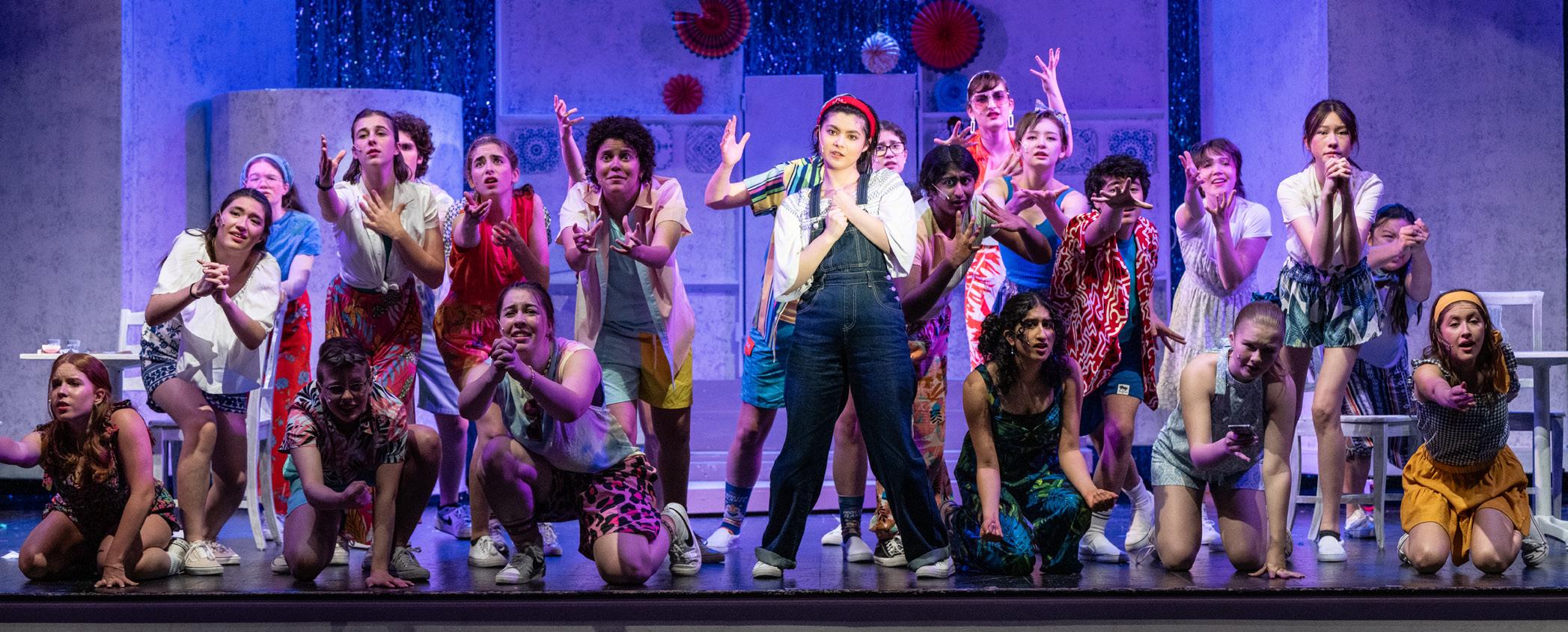
A wedding to remember Students marry song and dance in spring
By Gabe A.Dancing Queens swept the stage at the Lower School on a four-show run of Mamma Mia! from May 10–12. Students in the Upper School Spring Musical class had prepared for 15 weeks of rehearsals leading up to the performances.
The 1999 jukebox musical follows Sophie, a young bride-to-be, with one wish: to walk down the aisle with her father at her side. The twist? She doesn't know who he is. Determined to uncover his identity, Sophie invites three men from her mother Donna’s past to the Greek Island venue, leading to hilarious yet resonant chaos. Set to the greatest hits of Swedish pop supergroup, the musical embraces joy and summer.
The cast faced multiple challenges in the months leading up to the performance, from the maternity leave of Co-Director Zoe Swenson-Graham until March, to an outbreak of strep. Still, under the guidance of Co-Director Zachary Isen, cast members stayed determined in the light of the setbacks.
“It was a challenge to do it without one director, but it was also helpful to have a new set of eyes once she returned,” said Jasper F. ’25, who played Sam—one of Sophie’s three possible fathers.
Amongst these changes, actors were tasked with orienting themselves in unfamiliar roles as well: Jasper as Sam and Brenna A.M. ’25 as Donna both had to adapt to their characters’ matured nature, taking on their new middleaged personas for the night.
For Ryley M. ’25, leading the show as Sophie, “the girl with golden hair,” they took to facing the challenge headon.
“I have a mullet and I’m not the girl with golden hair,” Ryley said. “So I had such a fun time making [the role] my own.”
These individual and cumulative efforts paid off, creating a performance to remember. For audience member Kelly P. ’24, the show’s lighthearted subject was a highlight.
“It was such a feel-good show. I left the theater smiling” said Kelly, who tuned in for the Saturday evening show.
“We enjoyed it so much that we decided to plan our senior trip as a vacation to Greece,” said Noor Z. ’24, accompanying Kelly.
My journey to Swiftiedom was grudging. As the Eras Tour became a focal point of pop culture last spring, I chafed at the public's ongoing and prurient obsession with Swift’s every move and prayed that her iron grip on the zeitgeist would wither. However, as I began listening to her albums last summer (Speak Now: Taylor’s Version was my gateway drug), I developed my own infatuation with her music. But right as my Taylor obsession was reaching fever pitch, she released The Tortured Poets Department on April 19.
By and large, the album is messy, unrefined, and so verbose that even its nearly 10,000 words lack substance.
TTPD’s opening two tracks are its most memorable, giving the chronological listener a warped sense of the album’s quality. “Fortnight”, the first single off the album, reinforces a recurring motif throughout her discography: she presents herself as a passive figure manipulated by the shifting gaze of onlookers and foes. She quickly deviates from this theme throughout the album by leveling blistering pathologies onto her lovers, but the lyrics in “Fortnight” soar. In the first verse, she sings: “I was a functioning alcoholic / 'Til nobody noticed my new aesthetic.”
“Fortnight” is a rare instance in which Swift marries lyrical precision with melodic pizazz, inviting Post Malone to duet on her gut-punchy chorus: “I love you, it's ruining my life / I touched you for only a fortnight.”
The titular “Tortured Poets Department” is the album’s strongest attempt at a poetic meditation on a volatile relationship. The song is rife with nostalgic imagery, weaving in references to songwriter Patti Smith and the notorious Chelsea Hotel in New York City. In the chorus, “Who's gonna hold you / who's gonna know you like me?” Taylor hints at the tension caused by an inevitable breakup with her lover. The track takes a sinister turn once Taylor reveals his manipulative machinations: “Sometimes, I wonder if you're gonna screw this up with me / But you told Lucy you'd kill yourself if I ever leave.” These tracks are
supplemented by co-writer Jack Antonoff’s synthesized overtones, which gel with Swift’s delicately crafted melody.
Cloaked in Swift’s lyrical ambiguity, the remainder of the album encapsulates what it ambitiously attempts but fails to deliver: presenting a nuanced poetic volume about the latest chapter of Swift’s life. Where lyrics in earlier albums like Folklore and Evermore were profound, refined, and fleshed out, the bulk of The Tortured Poet’s Department feels like a haphazard amalgamation of unworked first drafts. Moreover, her lyrics seldom fit sonically within the context of their chord progression and melodies, as if Swift were forcing the coalescence of her music and poetry—when both art forms seem to exist in contrast. Swift’s lack of lyrical refinement in TTPD was an unexpected letdown for an artist so exacting in her lyricism.
Songs like “My Boy Only Breaks His Favorite Toys,” and “I Can Fix Him (No Really I Can),” blandly fade into one blank canvas. Both tracks show Swift stripping her former lover of any complicity in any harm caused to her. In the former track, Swift presents an androcentric pathology of her ex, describing him as a child who breaks “his favorite toys,” callously destroying sand castles wherein she’s the queen. In the latter track, she presents a self-indulgent character study about her ex, framing herself as the savior of a broken man. She describes him as the “perfect case for [her] certain skillset.” Even though friends “shook their heads saying, ‘God help her,’” Swift’s chorus doubles down on her assertion: “I can fix him, no, really I can.” By rendering her ex’s arrogance a result of his masculinity, she absolves him of responsibility. Lyrics like “Good boy, that's right, come close” in the latter track demonstrate how Swift views this man as a child. Rather than holding him accountable, Swift’s lyrics appear patronizing and sympathetic. Eager to decode her enigmatic lyrics, many Swifties theorized that both songs reference Swift’s relationship with Matty Healy, an English songwriter known for his prejudiced jabs. While the overdone tracks may be interpreted as a condemnation of Healy, they came across as a justification for dating him in the first
place. Swift strives to emerge as a hero in the debacle, tying an illustrious bow on an ugly scandal.
Throughout the album, I found myself wondering why the endless breakup songs were ineffective in eliciting an emotional response. Was it the lack of emotionally resonant lyrics? Was it the absence of musical variety? Through further contemplation, I realized that the album was not a volume of work written for the masses, but a sanctuary for Taylor’s interiority. Lyrics feel analogous to the impassioned scrawls one may write in a scrapbook or diary rather than a fully realized body of work.
Rather than salvaging a deeply flawed volume, Tortured Poets Department: The Anthology—the accompanying deluxe album complete with 15 bonus songs—only (reinforces) its implicit flaw: the prioritization of abundance over quality. While tracks like “The Albatross” offer lyrical depth (“Wise men once read fake news/And they believed it”), many of the added tracks fall victim to the same monotonous synth chords and restrained harmonies.
Most tracks in the anthology album are forgettable, but “I Hate it Here” has become digitally notorious for an off-color lyric. In a song where Taylor envisions an escapist venture out of the present, she sings: “My friends used to play a game where/We would pick a decade/
We wished we could live in instead of this/I'd say the 1830s but without all the racists.” Online, non-Swifties were quick to decry this lyric, arguing that Taylor was demonstrating cultural ignorance, glorifying a grisly period in American history. “I Hate it Here” is the most apt and painful figment of the album’s careless nature.
While I will always adore the heartbreaking rawness of Speak Now, the evergreen hits of 1989, the unrestrained fury of Reputation, and the dreamy overtones of Lover, I will not be enrolling in the Department of Tortured Poets.

I once had a friend say he’d break his lifelong vegetarianism to try xiaolongbao, or Chinese soup dumplings. Now, I’ve never been vegetarian, but I think it’s a telling testament to the dish’s appeal.
Xiaolongbao, which translates literally to “little dragon dumpling,” is thought to have originated in Shanghai suburb of Nanxiang over 150 years ago. What sets it apart, however, is the jellified meat stock mixed in with the pork filling. Bundled up in a delicate flour wrapper, taking a bite of xiaolongbao is delightful. The savory umami broth bursts in your mouth, perfectly complimented by tender pork and a slightly chewy wrapper.
The very best xiaolongbao is obviously in Shanghai. But for those of us whose schedules can’t accommodate flying halfway across the globe, here are the best xiaolongbao spots in the Bay.
I-Shanghai Delight
6016 Stevenson Blvd, Fremont
At a volleyball tournament in seventh grade, sick of team dinners consisting of overcooked alfredo pasta and soggy fries, my parents and I ducked into a hole-in-the-wall Chinese spot in Old Sacramento. And thus, a yearslong obsession with Shanghai street-food chain I-Shanghai Delight was born. They have locations in Sacramento, Fremont, San Ramon, and recently opened in San Jose’s Westfield Valleyfair Mall (although I can’t attest to the quality there).
The former two have never failed to impress.
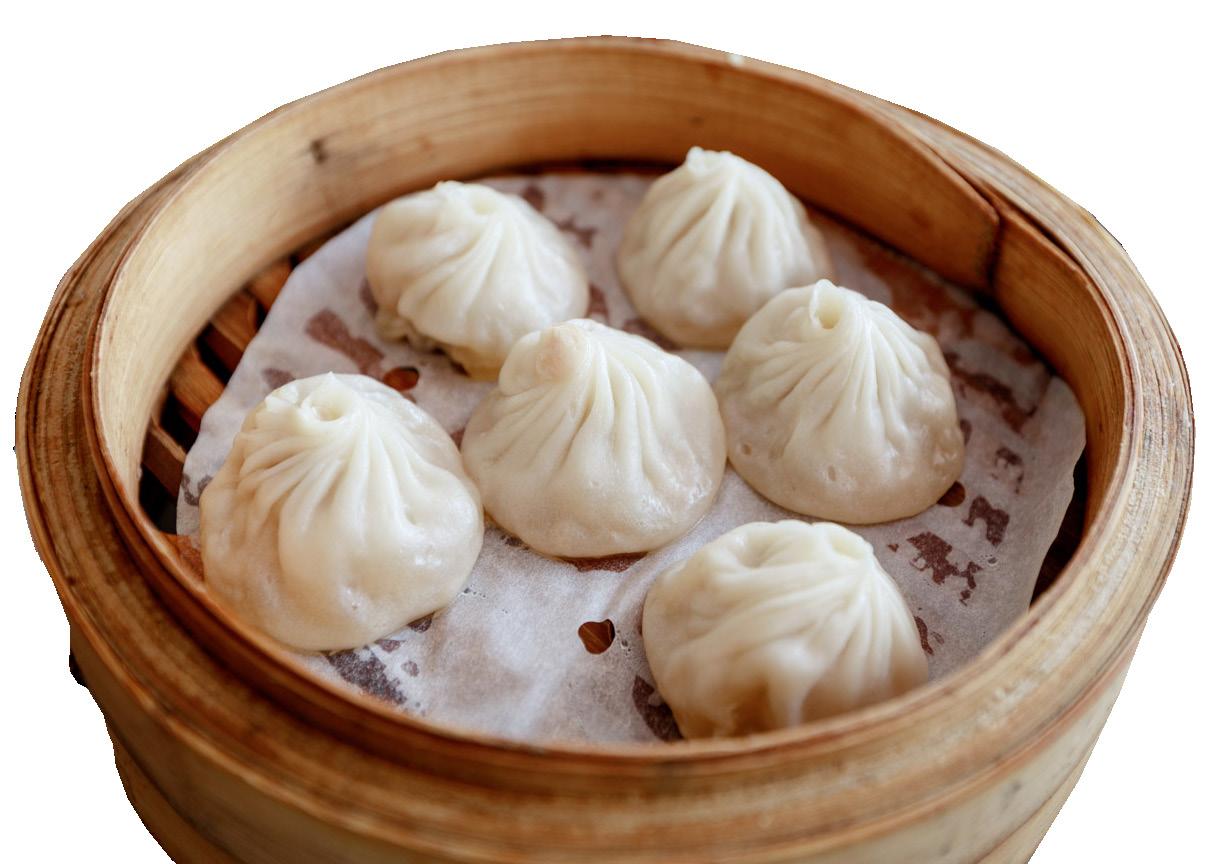
Walk in and be entranced by the chefs constantly kneading and pinching out new batches of the signature dish. While the skin is slightly thicker, each dumpling is huge and bursting with broth. For years, I ate it without the complimentary vinegar and ginger dipping sauce—it’s that flavorful on its own! For $10.99, you can’t beat that.
10235 S De Anza Blvd, Cupertino
Tucked away in a small outdoor patio, surrounded by dim lights and the constant shhhhhhhshhhhhhhh of a small fountain, it’s easy to forget that you’re just off the Highway 280 exit in Cupertino. That is, until a piping hot zhenglong (bamboo steamer) is carried out of the kitchen. That authenticity can only be found in Cupertino.

As the name suggests, this spot specializes in xiaolongbao. And boy do they live up to their namesake. XLB’s signature dish has a slightly sweeter taste than some of its Bay Area counterparts. My mom loves joking that this taste may be preferable to those of us with…less melanin. Don’t fret, though, because no authenticity is comprised. Rather, XLB’s dumplings are reminiscent of Suzhou and Wuxi palettes, perfectly balancing out the meaty pork filling.
Din Ding Dumpling House
1779 Decoto Rd, Union City
Somehow, I seem to discover all my favorite restaurants during slightly distressing extracurriculars. I entered Din Ding Dumpling House in Union City hoping to soothe my debateravished soul. Biting into the delicate skin, the cascade of broth that greeted me confirmed that I’d be a new regular in times of distress. Don’t trust me? Trust the Chinese families that pack into the establishment at every mealtime.
Diapers, tears, and iPad kids are no match for these child-proofed high schoolers.
 By Josie B. & Ellie K.
By Josie B. & Ellie K.
It’s a Saturday night, and Noor Z. ’24 is creating a plan for her evening shift. Middle school math packets, rounds of the board game Apples to Apples, episodes of Bluey, conversations about school, and countless instances of shuffling and reshuffling decks of cards will soon fill her next few hours. No matter what she decides to do, Noor is sure to have her hands full. When her clients consist of babies, toddlers, and pre-teens, there is never a night exactly like the next.
Noor is a member of the Upper School’s Babysitters Club, a network of sitters who provide contact information to the Nueva Parent Association (NPA), which then connects sitters with primarily Lower School families.
Dara Silverstein, who has two children in the Lower School and is the outgoing co-president of the NPA, grew up loving Ann Martin’s baby-sitters club books. As a teen, she became a babysitter herself, spending her Saturday nights supervising local neighborhood children. Like many parents of Lower School students, she struggled to find reliable babysitters for travel, school events, and date nights following the pandemic. After hearing about an Upper School Babysitters Club that existed pre-pandemic, she decided to take action.
In the fall of 2023, Silverstein kicked off the club with the help of Upper School Dean of Students Jackee Bruno. Upper School students sign up for babysitting jobs through a Google spreadsheet. After students sign up, Silverstein connects the sitters and families over email. On Nueva events like back-to-school nights, Silverstein can receive dozens of requests for sitters.
“At the time I started the club, I didn’t realize how much it would help families,” Silverstein said. “Before this program, I too was hesitant about buying concert tickets or plane tickets because I knew I would have to go through the work of finding a babysitter.”
Silverstein frequently uses the program for her own children and has enjoyed its ability to connect her with the larger Nueva community.
“There was one week recently when my husband was away, and I needed four nights of babysitting,” Silverstein said. “We got to meet three different Upper School students, and the amazing thing for me was that they all seemed to be friends with each other. There's a ‘small world’ aspect that I love.”
Noor started babysitting in seventh grade, eager to take on the responsibility of caring for kids and earning income. Since then, she’s connected with multiple kids throughout her community. As the youngest in her family, babysitting has let her experience the role of being an older sibling.
“Doing regular babysitting for one
family and seeing them grow over time while building a close relationship with the kids is so fulfilling,” she said. “It’s rewarding seeing the kids as time goes on—they listen to you and respect you more.”
There is never one babysitting job like the rest. Some nights are challenging— inexplicable tears, bedtime delays, or sibling squabbles—but other nights remind Noor why she loves to babysit. When she babysits one particular first grader from the Lower School, his passion for states, capitals, countries, and flags becomes her niche for the night.
time Jordan comes over.
“It’s not just about the dance; it’s a whole ordeal,” she said. “She dresses me, she does my hair, she does my makeup, and then we learn the TikTok dance. It’s a very humbling experience.”
Jordan began babysitting in freshman year, excited by the prospect of earning money and managing her own working hours.
“Discipline is the hardest thing: balancing that you’re not their parents but you can’t parent,” she said.
As a babysitter, Jordan doesn’t want to overstep the boundary between her role




Clockwise from top left: Jordan and the kid she babysits pose in matching eye masks and headbands; bunny-eared Jordan smiles with the kids she babysits; two hands up for cookie decorating, a go-to activity for Anjuli's babysitting nights; board games are a popular way to spend the time for Noor.
“He is always having me quiz him on the capitals of the most obscure countries ever,” she said. “I’m sitting there [thinking], ‘Wow, I’m learning from you and you’re half my age.’”
For Jordan D. ’24, babysitting duties include choreography, a uniform, and a makeover. One girl she babysits requests to learn a TikTok dance together every
and that of a parent. However, she feels immense joy seeing how she’s supporting the kids’ growth.
“[It’s so fulfilling] when I see two siblings figure out their problem when I used to have to do that for them,” she said.
Jordan works with three families consistently. One family she sees up to five times a week. Beyond how rewarding she
finds the process, she’s most surprised to realize how attached she’s become to her young charges.
“I’ve bonded with them so much,” she said. “I’m going to miss them when I go to college.”
Similarly to Jordan, when asked what was most meaningful about babysitting, Anjuli M. ’25 began with, “I love my kids so much!”
As she is not a member of the Upper School’s Babysitters Club, Anjuli coordinates jobs on her own, working with neighbors, relatives, and family friends. Starting babysitting in seventh grade, Anjuli has worked with a single family for over 200 hours. In a way, she feels like she’s become “a part of their family.”
“When you babysit for people you don’t know as well, you feel like you have to have a performance and be put together,” she said. “When I go to their house, I don’t have to be Anjuli-MissPerfect-Authority-Figure; I feel very comfortable there.”
Anjuli expressed gratitude for having the opportunity to watch “her kids” grow up. Despite having a younger sister, she describes how “rare it is to have people at that age” in one’s life unless that person has a significantly younger sibling.
Willa B. ’27, who started babysitting just over a year ago, has also already found babysitting to be a conduit for confidence.
“I've felt more confident when talking to adults as well, not just kids,” Willa said. “Having to deal with younger kids all the time who are much less decisive has made me more decisive.”
For Noor and Jordan, babysitting has given them a profound appreciation for and understanding of children.
“It’s easy to be critical of children, but it’s important to realize this is their first time experiencing so many things that they don’t know how to handle,” Noor said. “It’s important to show some compassion to them.”
As someone interested in psychology, Jordan is quick to notice how children learn and develop as a result of their surrounding environment.
“The way kids act and pick up on things around them and then assimilate [those things] into a part of themselves is so powerful,” she said. “You can’t always blame kids for the way that they act because most of the time, it’s something they learned from people in their life.” Through babysitting, Anjuli has learned more about herself: before this experience, she wouldn’t have imagined herself in a caretaker role. Now, she tutors elementary kids in addition to babysitting. From working with young children, she’s learned about the importance of listening to their ideas. Of course, she’s also discovered that they can cry about anything, and most of the time they’re okay. But most importantly, she’s learned that Bluey is a truly great show.

Read about the unique summer opportunities students are pursuing
By Alvin Y.
On the coast of Alaska, Natalie C. ’25 will explore the state and her surroundings by foot and kayak while helping the Tidelines Institute run smoothly.
The Tidelines Institute offered Nueva students a unique summer opportunity to travel to Alaska, where applicants must live and work on a five-acre home. Students provide support for the team by conducting a variety of activities, ranging from the ability to plan courses, managing chickens, and even occasionally babysitting two children.
During the internship application process, Natalie was aware that she wanted to be outdoors working and doing something physical for her summer. She applied for a variety of internships outside of the Nueva internship program, ranging from trail crews in Yellowstone National Park to Minnesota.
However, after being introduced to the Tidelines program by internship coordinator
Thane Richard and hearing the stories of previous interns, Natalie was immediately drawn to the program.
“I read the bios of everyone who works there,” Natalie said. “They all just sound like super interesting people to get to know, and I think I'll change the way I see the world in some way.”
Natalie is also excited to learn from Tidelines staff and use this experience for a potential future career. For example, she described the program’s “woofers,” who work part-time on farms worldwide, learning about the local culture and maintaining sustainability.
“Maybe I do woofing or pursuing environmental science and trying to get into research because they also do research up there,” Natalie said. “I feel like I get to see a pathway into what type of careers I feel like I might do.”
Among the busy markets along Coco Beach in Tanzania, few locals are seen on the white, sandy beaches. However, an unexpected thing can be seen—one of the first lifeguards at Coco Beach, thanks to Remi C. ’26 and his goal to stop the 3,000 annual drownings in Tanzania.
In his program to hire qualified lifeguards for Tanzanian beaches, Remi will travel back to Tanzania to further build on to the growing program. Remi first began the project in August 2023, when he first asked his cab driver about the lack of people on the beach.
“We were driving along a road and I didn't see that many people on the beach and I asked why,” he recalled. “My cab driver said the government says there's spirits in the water that'll take your kids.”
Additionally, Remi, being a prolific swimmer and certified lifeguard with familial connections to Tanzania, wanted to impact the community he
visits every year.
“I feel a deep connection to the water,” he said. “I had to solve the problem, or at least try to.”
In his time raising the program, Remi has built a tight relationship with the Tanzanian community, where he keeps learning new things every day.
“I don’t speak Swahili, but every single one of them said they would teach me Swahili when I talked to them,” he said. “Everyone there is nice, and I think all the lifeguards are a perfect example.”
Even with an established community and properly trained lifeguards available, there is still work to do to complete the project, Remi said, as it still needs proper equipment, lifeguard towers for better visibility over the beach, and formal recognition for the current lifeguards from the Tanzanian Life Saving Society.
Jamming to her “daydream” playlist, Sasha C. ’24 unboxed her new chisel tip markers and set to work one recent April morning. Five hours, 10 hand-drawn cups, and 18 employees’ uniquely lettered names later, she stepped back from her final product: a three-by-10 foot mural at local boba shop Urban Ritual.
The project was her first paid commission, which she reflected on as a meaningful opportunity and milestone in her portfolio as an artist.
“I always thought that my art would be something very personal. To have my work valued that much was just really special to me,” Sasha said.
However, Sasha was no stranger to contributing her artistic talent to her local communities. At Nueva, her artwork is bountiful on the walls, publications, and social media platforms.
For Sasha and Nueva, it has been a twoway-street: she has volunteered her artistry to the school and in turn the school has supported her in accessing materials, finding new opportunities, and building connections over the past four years of her time as an Upper School student.
Outside of school, Sasha pursues lettering
for more personal projects. Her first foray into calligraphy occurred during the pandemic, when she remedied her boredom by following YouTube tutorials on bullet journaling, a form of artistic journaling with dots instead of lines on the pages.
The learning curve for lettering and calligraphy was steep. Sasha studied techniques such as maintaining her pen’s angle, emphasizing certain strokes, and adding shadows for emphasis. “It’s not until after you master those skills that you can start adding a personal flare,” she said.
Once Sasha began to craft hand-lettered greeting cards for friends and family, she realized how many people appreciated the art of calligraphy.
“Community members love to see the things that matter to them portrayed in color and with an artistic flare. It shows that someone cares and is willing to put in lots of time and effort to share that,” she said.
Sasha then began to translate her skills and talent to the Upper School campus. As a member of Nueva’s Discussion and Talks About Science club (DATAS), Cocquyt is the primary artist of chalkboards advertising the club’s signature Science Fridays. Her everrotating sandwich boards are a hallway fixture that students admire as they pass, defined

Pearl Y-L. ’26 can almost imagine her newest opportunity in the heart of Detroit: the promising expanse, surrounded by the bustling Motor City, waiting for an urbanized, environmental renovation.
This year, Pearl and three Nueva students will travel to Detroit for an internship, helping to develop the Planet School, which is built on abandoned land acquired from the government and aims to be tuitionfree.
The initiative requires student interns to be in Detroit for two weeks, practicing a variety of life skills as they prototype urbanized agricultural elements to the school, constructing urban farm installments, and even test out a sailboat and its hardware in the nearby lakes.
“I think this will be a great opportunity to practice taking initiative because there are so few people working on this project,” Pearl said. “I would be applying my knowledge to impact organizations, and work alongside adults, which is an opportunity we don't get at school very often.”
Some elements of the internship are still undecided. Still, Pearl is already excited to spend two weeks in an unfamiliar city.
“I think one of the coolest things about the internship is that you get to be in a new place,” Pearl commented. “Not only that but being able to learn about the challenges of another community drew me into the program.”
Additionally, Pearl has attended multiple unique schools from elementary to high school, as she attended a school with a farm in elementary school and Nueva from middle school to now. This heavy involvement drew her to the unique program and allowed her to recognize the importance of the in-development school.
“I’ve recognized how important these kinds of environments are for fostering a love of learning and social-emotional growth,” Pearl said. “I think it's really cool that maybe people could have the same opportunities I've had, without that cost being as much of a barrier.”
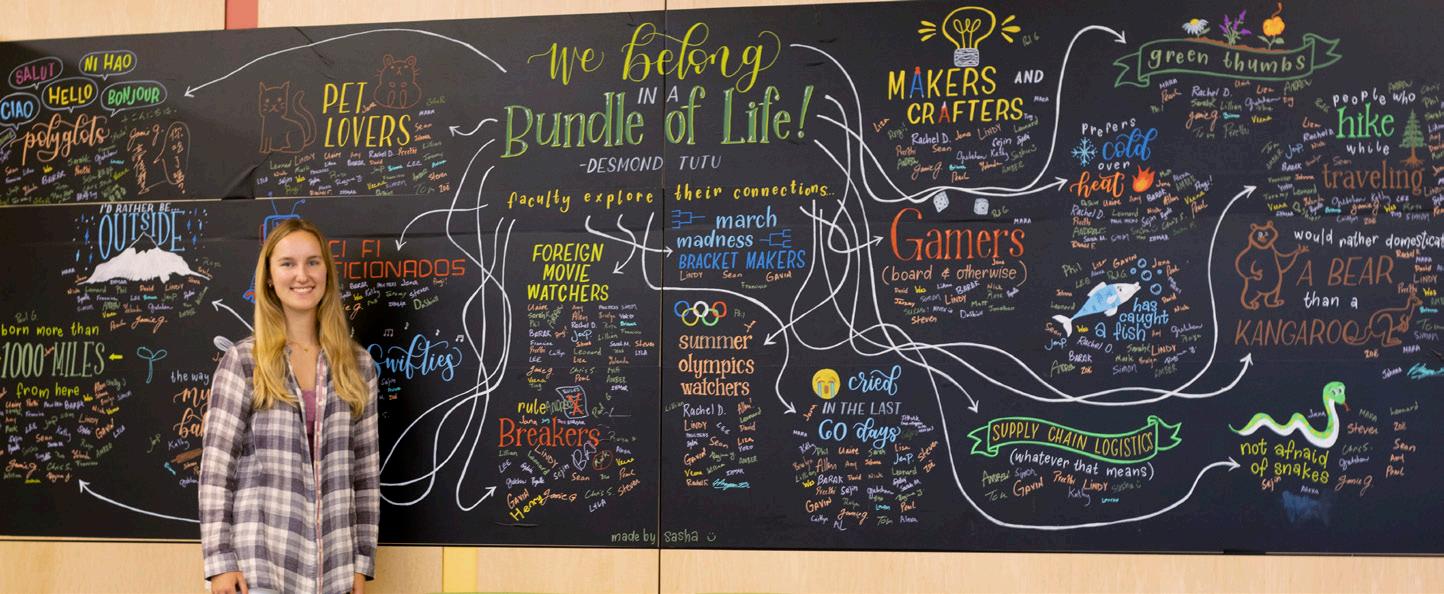
by their loopy cursive, vibrant colors, or charming drawings.
Additionally, Sasha has contributed her time and artistry to the “Bundle of Life” installation in front of the Writing and Research Center (WRC), which highlights the interconnectedness of faculty at Nueva; a project for Director of Teaching & Learning Lauren Pool on learning at Nueva; and branded stickers for Nueva's strategic framework.
As such, Sasha contributions to Nueva and its surrounding are just one of the legacies she’ll leave behind after she graduates. While her artistic focus on calligraphy is personal, she also realizes the impacts of it on others.
“My time at Nueva has made me realize that I find joy and fulfillment in bringing people together simply by doing what I love,” she said.
Sasha plans to continue her hand lettering
CHALK IT UP
beyond high school. This summer, she hopes to find a job at Trader Joes—where all chalk artists are also employees—and potentially pursue more commissions. Enrolling in the fall at Princeton University, she hopes to support student groups with her artwork.
For now, though, Sasha is working to find a new artist for Nueva’s own Science Friday chalkboards next year, and she is welcoming to less experienced calligraphers.
“It does take practice. But start small and just doodle. I’m hoping that more people get into this kind of art here,” she said.




Here’s where the Class of 2024 is heading after Nueva

















are staying in California for college is the most popular intended major—10 seniors plan to study the subject
are attending private colleges
5,091
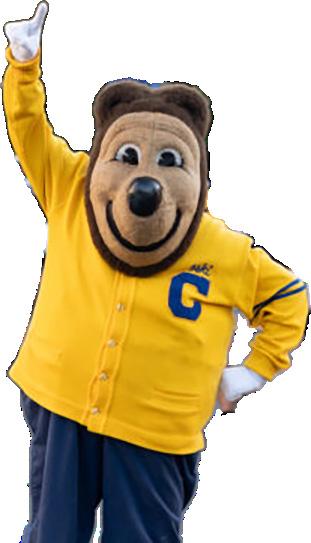
miles from Nueva to Trinity College Dublin, the farthest school plan to pursue a double major total applications submitted this year applications submitted per student, on average
There isn’t one single metric, word, or path that can perfectly encapsulate the Class of 2024. It’s like a puzzle—here are some of the pieces.
1,522 13.7
colleges being attended for the first time by Nueva Upper School graduates:
- Pennsylvania State University - Trinity College Dublin - Tulane University
- University of Maryland, College Park - University of Ottawa
- University of Washington, Seattle - University of Waterloo are currently undecided on their major


Nationally, a firestorm of debate has surrounded DEI as states introduce legislation to dismantle DEI systems.By Gabe H.
When Mars shared this interaction with peers at Nueva, hoping for empathy and commiseration, their peers instead defended the student’s words. A number of their Upper School classmates felt that there was merit to the claim that Black people are given an unfair leg up due to affirmative action, whereas Mars maintained that its true goal was to “level the playing field.”
“I think that the mindset that affirmative action was raising [minorities] above everybody else is very damaging,” Mars said. “They lack perspective and understanding.”
Even within the predominantly “liberalminded community,” as US English Teacher Jennifer Neubauer described the Upper School, then, consensus on DEI is no guarantee, and skepticism is plentiful.
Pablo Z. ’27 acknowledged that changes to advance DEI goals may sit uncomfortably with some individuals, but believes this discomfort to be necessary.
“With change, there's always backlash, but with change there can also come improvement,” Pablo said.
Pablo, who identifies as half Chinese, part Bolivian, and part Chilean, has a unique perspective on criticisms of DEI from Asian communities who feel that the policies unfairly privilege Black and brown communities.
“There is this portrayal of DEI as something that only helps certain communities, and I don’t think that is the case,” he said.
In late 2023, amid the legislative backlash to DEI, the narrative of its “unfair” aid to minorities came into play in high-profile fashion at Harvard University. Claudine Gay, the university’s first Black president, was widely criticized following her appearance before a congressional committee to speak about Harvard’s institutional response to antisemitism on their campus. Shortly after, Gay’s critics accused her of plagiarism. When Gay resigned, conservative movements capitalized on her status as a Black woman in a leadership position at Harvard as evidence of DEI policies gone too far.
One of the most prominent critics of Gay and DEI was billionaire hedge fund manager Bill Ackman. He posted a 4,000-word tweet on X, calling for abolishing DEI programs in educational settings. In his tweet, he wrote that DEI policies advance “inherently a racist and illegal movement in its implementation even if it purports to work on behalf of the so-called oppressed.” His post was soon retweeted by tech billionaire Elon Musk, who suggested that DEI was “another word for racism,” discriminating “on the basis of race, gender, and many other factors.”
According to Jelani Cobb, the Dean of Columbia University’s Graduate School of Journalism, conservative criticisms of DEI— like ones espoused by Ackman—stem from prejudiced grounds.
“[DEI] has been brought up as part of a dog whistle to suggest that white people are losing out on opportunities because people from other backgrounds are being included,” Cobb said in a phone interview.
Taylor agreed, adding that “we treat resources like a zero-sum game. [Critics of DEI] think that somehow if somebody else has a seat at the table, they no longer have one.”
Cobb offered a refutation to the arguments that challengers of DEI policy have posed.
“Over the course of time, people came to understand that we live in a complicated, multicultural, vastly heterogeneous society.
To have people who broaden the perspective of organizations: whether it be educational, business organizations, military, etc—has been generally recognized as a benefit,” he said.
He also questioned the motive behind conservative attacks on DEI in conversations about Claudine Gay. “Harvard has existed as a university for over three hundred years,” he

“We can and should do better. [Since incidents continue to happen], the programming that we have established does not work.”
Zara M. ’25
families, students in grades eight through 12, and faculty and staff, to better understand the lived experiences of community members. The survey aimed to identify areas of success and improvement. The feedback on the social justice curriculum was mixed: More than 50 percent of families felt that Nueva “places the right amount of emphasis on social justice, while one-third feels that it may be overly emphasized.” Faculty and staff wanted improvements to the social justice curriculum, and students desired “less talk, more action.”
For Kate K. ’24, DEI initiatives at school are loosely defined.
“I’m never quite sure where our DEI efforts lead at Nueva, and I’m not sure which things we can point to as part of Nueva’s DEI initiatives,” she admitted. “It feels nebulous and vague.”
To Pablo, reading in the news about the strip down of DEI work is harmful.
“When I think of DEI, I think of programs and policies that are giving chances to historically and systematically oppressed communities,” he said. “I think DEI was really made to help these communities and I don't think it should be taken away.”

For that reason, Pablo appreciates the support systems in place at the Upper School that help students from underrepresented backgrounds find community. He cites the THRIVE program, which supports students and families who have been historically underrepresented at the Upper School, and student-led affinity spaces available on campus, as successful initiatives.
Other students assert that there are still gaps DEI programming at Nueva should fill.
As the Upper School’s Diversity, Equity, and Inclusion Representative, Zara M. ’25 works closely with E&I team members like Upper School Equity and Inclusion Coordinator Steven Mathis and fellow Student Council representatives.

said, and added that no Black person before Gay had ever held office as president. “The one black person who is,” he said, “is derailed as a diversity hire. They’re saying that for three and a half centuries there were no black people qualified.”
DEI at Nueva Last spring, Nueva surveyed current
In her role, she has heard of incidents of the N-word being verbalized by non-Black students in casual banter and jokes about sexual harassment occurring frequently among students.
In her grade, Anika G. ’26 has witnessed a casual appropriation of Black culture by certain community members. She noted that many students incorrectly use African American Vernacular English, an evolving language of colloquialisms coined by the Black community.
“We can and should do better,” Zara said. Since these incidents continue to happen, Zara sees it as a sign that the existing programming needs to be re-examined and iterated.
Other students noted that Nueva lacks a
robust enough equilibrium between holding students accountable for bias and fostering a growth-minded atmosphere. For Olivia C. ’24, finding that perfect balance is essential.
“Over-policing can also lead to overcompensation,” Olivia said. “If you think of [authoritative directions] as a swinging pendulum when you force people to go one way, it’s in our nature as teenagers to want to go the other way.”
Yet, she still emphasized the importance of accountability and appreciated the DEI culture of “calling students in,” or not immediately penalizing them for biased acts but rather treating bias incidents as learning opportunities. Olivia said that a toxic motivation behind cancel culture is to “immediately de-platform” individuals who commit acts of bias.
Sofia T. ’24 was active in advocating for an anonymous reporting system for bias incidents. As a co-lead of the Upper School’s Queer Student Union, she met regularly with faculty like former Director of Social Justice and Equity Savannah Strong and former Upper School Equity and Inclusion Coordinator Matthew Oakland to codify this policy last year.
“It was something that would have opened doors for a lot of students who may not feel comfortable yet coming forward with a name attached to it,” said Sofia, referencing the reporting system, which was enacted this May.
In the absence of a Director of Equity and Inclusion for most of this year, Dean of Students Jackee Bruno has assumed various additional DEI responsibilities, including partnering with Mathis and Upper School Counselor Sydni Marmor to roll out the bias incident policy. He also worked with Mathis to set guidelines for student leaders of affinity groups and worked to support female students pursuing STEM courses.
Another initiative some students seek improvements on is the Nueva Honor Council.
Students like Anika believe increased usage of the organization could further DEI practices at Nueva. The Honor Council is a group of six students who aim to assist the administration with disciplinary actions and facilitate restorative justice, the Upper School’s primary engine of discipline. Their mission is to “serve as a bridge between the admin perspective and the student perspective,” according to Anika, who is a council member. Led by Mathis and Upper

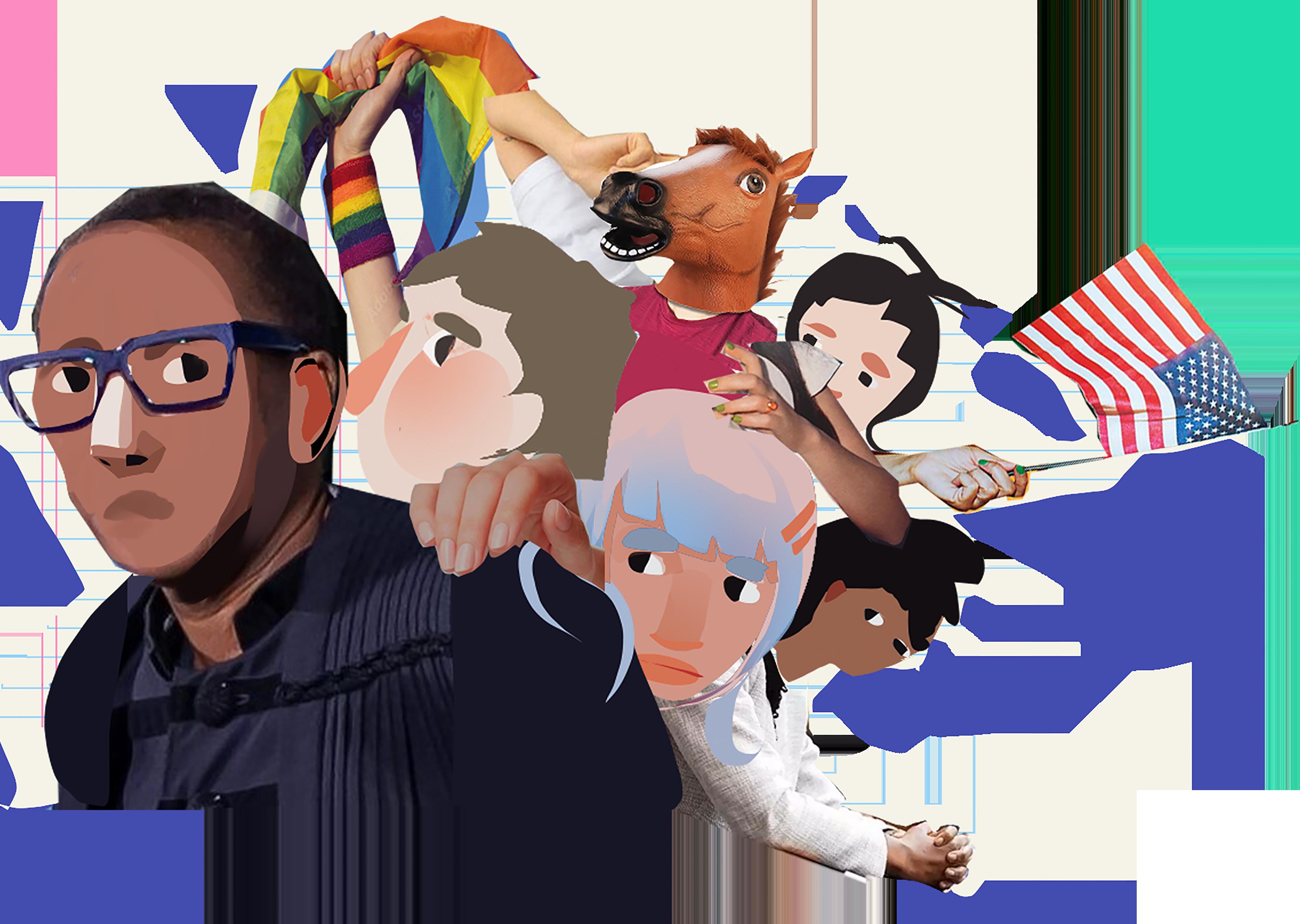
The Chronicle of Higher Education has been tracking legislation that would prohibit colleges from having DEI offices or staff; ban mandatory diversity training forbid institutions to use diversity statements in hiring and promotion; or bar colleges from considering race, sex, ethnicity, or national origin in admissions or employment.
85 bills have been introduced in 28 states since 2023.
14 have final legislative approval, and 14 have become law.
14 states have banned or restricted mandatory DEI training.
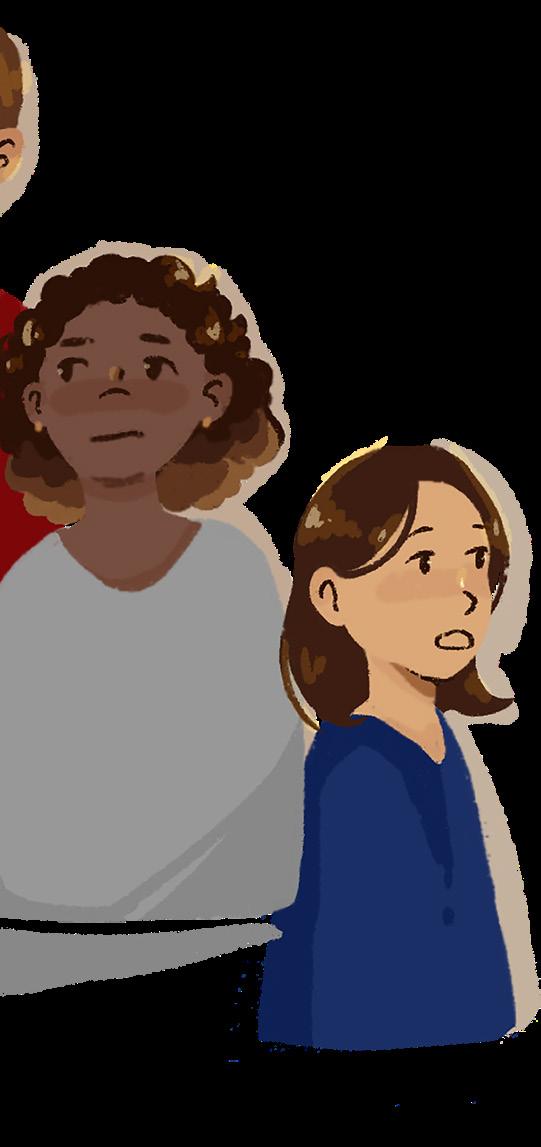
10 states have restricted DEI offices and staff.
49 bills have been tabled or vetoed.
through an application process that involves an essay and restorative justice training sessions.
Anika said that the group is “underutilized” and doesn’t reflect the potential a student organization can have for interrupting a culture of bias. Describing other schools’ honor councils like that of Berkeley High School, Anika said they operate as a “sounding board for how to deliver messages to the student body,” serving not just as a conduit between administration and students but a resource for mitigating conflict.
Anika stressed that Nueva’s Honor Council would be better utilized by facilitating more restorative circles when incidents of bias occur.
“Having the Honor Council be more involved in restorative justice education [would be] not just reactive, but proactive,” she said.
Logan R. ’24, another member of the Honor Council, said that DEI is a necessary part of Nueva’s internal processes, recalling an incident when a student used the n-word in combination with the school’s logo in a Reddit post. The school swiftly convened an all-hands assembly to address the incident. In 2022, the school’s efficient response to a public incidence of anti-semitism was also a testament to the administration’s strength in addressing incidents like these, Logan argued.
However, for Anika, a key element of restorative justice is lost at Nueva: consequences for actions of bias that extend beyond a mandated restorative conversation.
“People commit the same patterns of behavior,” Anika said, adding: “I don't think the consequences for actions are enough to get people to actually change.”
In tandem with survey results revealing a student desire for “more action,” some students are eager to know how, exactly, Nueva is emphasizing DEI.
Logan noted that Nueva’s commitment to diversity is sometimes too communicationsheavy and lacks substantive action.
“We get into a performative loop,” he said, adding that “advertisement is sometimes a barrier to action.”
Moreover, while online messaging about Nueva often emphasizes inclusion, Isabel Q. ’26 wishes there was more granularity about diversity efforts at the Upper School.
“I wish there was more transparency surrounding what exactly the school is doing related to diversity and those [DEI] values,” she
action.
“I think a lot of the time when we talk about affirmative action, we become upset about this idea that universities are accepting minority students just because they are minorities. That’s just not the case,” Isabel said.
One place where both students and teachers feel is ripe for increasing understanding of

“I wish there was more transparency surrounding what exactly the school is doing related to diversity and those [DEI] values.”
Isabel Q. ’26

DEI values is at the curricular level. Neubauer and other English teachers have been vocal in advocating for the integration of DEI work into the English curriculum. During her first several years at the Upper School, she collaborated with former Diversity, Equity, and Inclusion Director Alegria Barclay and former Equity and Inclusion Coordinator Alison Williams to integrate social justice learning.
On a local level, Pablo emphasized that Nueva’s approach to DEI is evolving and improving to be as inclusive as possible. “We’re never going to reach a perfect society where bias is gone, but I think Nueva is reaching as far as it can and trying its best,” he said.
While the status of DEI initiatives nationwide is in flux, Nueva has remained steadfast in its commitment to preserve DEI on its three campuses.

Ayaan M. ’26 has been mistaken for students of his ethnicity several times. He has had his name botched and garbled, used for jokes, and spelled wrong on multiple occasions. But when he got another student’s rubric, it just felt “insensitive.”
“I could chalk it up to a mistake, so I just found the other student and switched. I tried to not make it a big deal,” Ayaan said.
Eventually, his parents corrected the teacher at conferences, when they saw the wrong rubric. The teacher profusely apologized. But the experience has stayed with Ayaan, especially as he’s faced more name-related microaggressions and struggled to speak up.
“On the outside, [correcting someone] never seems like a big deal. But then when I’m correcting someone, it feels like a big thing. Am I being too mean? Am I being too harsh? Are they going to hate me forever?” Ayaan said.
Ayaan is not alone in his experiences. Almost 48% of non-white adults reported experiencing name-related microaggressions in a 2024 survey conducted by Samsung. Microaggressions are instances of indirect, subtle, or unintentional discrimination
against members of a marginalized group. The subtlety of microaggressions, especially those related to names, can make them hard to address or correct.
Not all microaggressions become as consequential as Ayaan's experience, and not all misnamings or mispronunciations are necessarily microaggressions. History teacher Sushu Xia noted that recognizing students has become more difficult over the past few years, given the rapid transitions from remote to in-person learning.
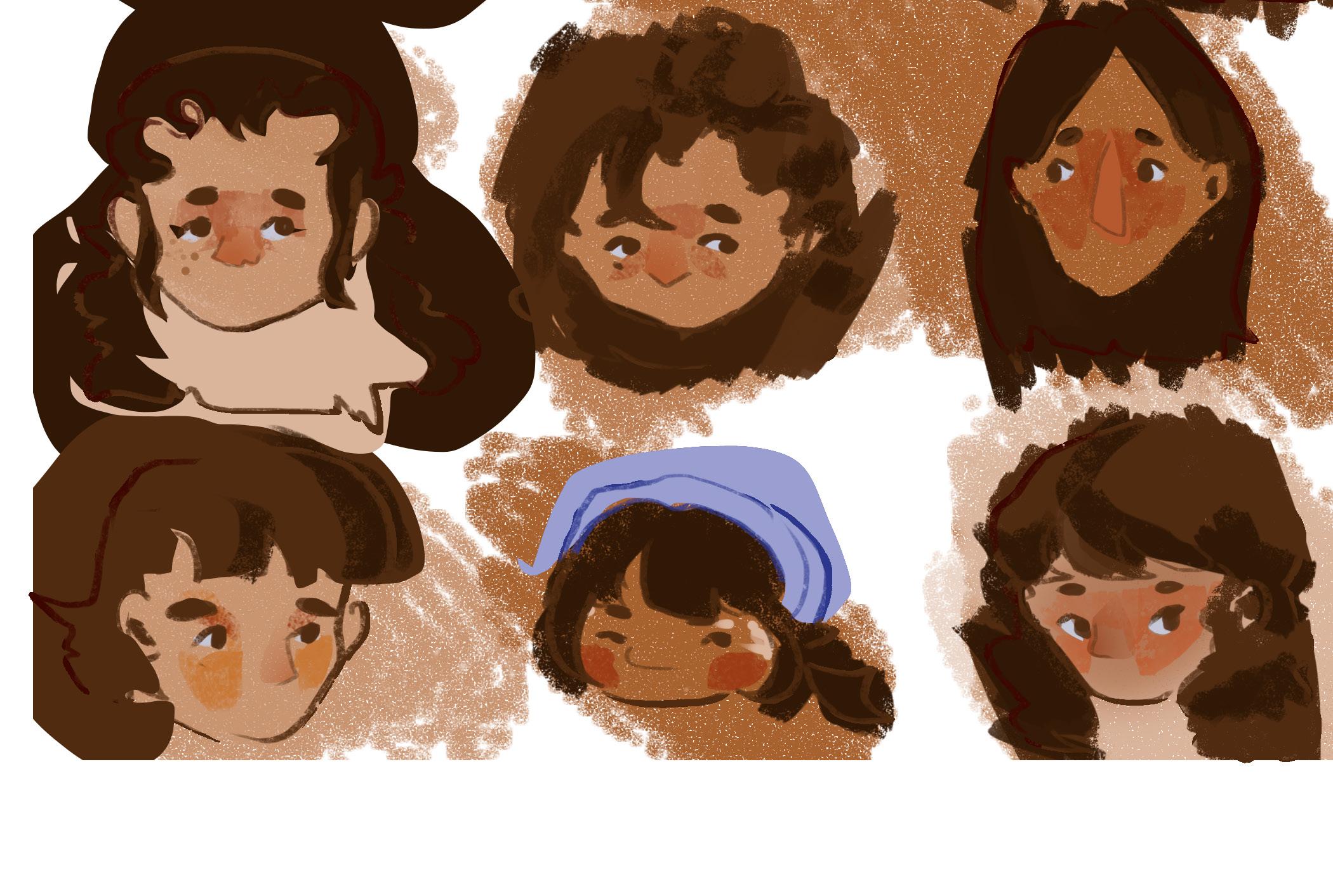
me,” said Tarun.
“When we moved from masking to not, I had just gotten to know the students from that part of the face. So I have definitely gotten students confused,” said Xia. “None of it is intentional. But [the changes] have made it harder for the last couple years.”
Tarun M. ’26 often tries to keep these factors in mind and give everyone grace, even as microaggressions “pile up.”
“There’s just that underlying feeling of something being off,” Tarun said. “It’s happened pretty much all my life.”
Since he has dealt with mispronunciations and misnaming his whole life, the one-off mistakes do not bother him too much. But when a teacher, after months of corrections, only adopted the correct pronunciation with his parents and not with him, he began to see
In comparison, Lucy K. ’27 has not encountered much misnaming throughout high school. Still, the repeated mistakes have the most impact, and are what she would actually consider microaggressions.
“If you asked me to tell you someone who got it wrong once but then corrected it, I couldn't tell you who those people are,” Lucy said. “But I can tell you who has gotten my name repeatedly wrong.”
When a coach called her by an Asian teammate’s name, Lucy didn’t think much of it after correcting it. When it happened again, she brushed it off. But after several months of misnaming, she started responding to that wrong name.
“I thought, okay, I’ll just be her for the rest of the season,” Lucy said. “It [made] me feel frustrated. And as if I’m just not noticeable.”
All of these different responses and reactions are often suppressed for fear of being deemed too sensitive or ungrateful. In
microaggressions during affinity meetings, but has found it to be a “harder conversation.”
“East Asians have a plurality at this school. As a result, there’s a sense of ‘we don’t need to talk about this,’” Xia said. “But these are conversations we should have. And [they] need to reach beyond EAST.”
DEI coordinator Steven Mathis has implemented a different approach to processing these microaggressions, in the form of the recently launched bias reporting system. Mathis aims to synthesize the data and feedback students provide about incidents in order to identify what areas the Nueva community needs to grow in and the necessary actions to help make amends.
“I think the change has to start first with acknowledging that, yes, we do make microaggressions,” Mathis explained. “I'm hoping that the biased incident report allows us to look at ourselves and see where we are as a community, and where we need to go.”
After a months-long search, Nueva hired Shawn Taylor to fill the position
By Gabe H. & Kayla L.On March 21, Head of School Lee Fertig announced in a community-wide email that Shawn Taylor was selected as Nueva’s new director of Equity & Inclusion (E&I). He had received a unanimous recommendation from the search committee.
Composed of representatives from each division—and led by Director of Enrollment & Strategic Engagement Taryn Grogan and Lower School Division Head Megan Terra— the committee screened diverse candidates from across the nation.
The searches followed former Equity & Inclusion director Savannah Strong’s departure at the end of the 2022—2023 school year.
Her sudden exit meant that the school had to conduct a “compressed” search for a new E&I director last spring, according to Grogan. Although the committee met with several candidates and brought at least two finalists to campus, ultimately they were unable to agree on a candidate.
“We just didn't find the right person,” Grogan said.
To assist with the search, the Upper School enlisted Educators Collaborative—an organization that helps schools hire qualified candidates in administrative roles.
In the context of equity and inclusion, Educators Collaborative works with schools to “devise strategy” around diversity initiatives, through supporting diversityoriented programs and assisting with efforts to increase enrollment of students of color, according to Andre Withers, a partner at the firm who assisted with Nueva’s hiring process.
Over an initial phone call, Fertig and Educators Collaborative exchanged values, priorities, and information about the scope and responsibilities of the job. Afterward,
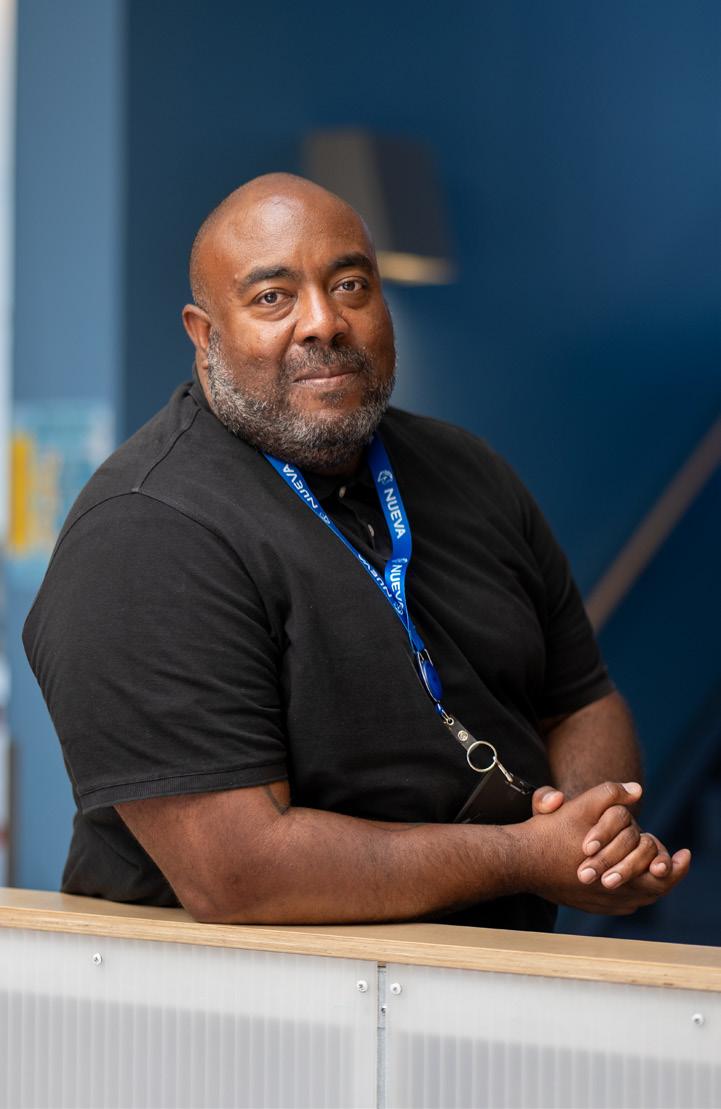 Photo by Kayla L.
Photo by Kayla L.
"We have to give every single person precisely what they need to flourish," said recently-hired Equity & Inclusion director Shawn Taylor.
Educators Collaborative determined Withers—who holds a background in diversity, equity, and inclusion work—as the best liaison for Nueva’s search team.
In working with Nueva, Withers found it “refreshing” to observe the school’s advanced progress in its diversity and inclusion initiatives compared to other schools with which he’s partnered.
Withers described school search efforts at Educators Collaborative as a balance of “passive and active” efforts. On the passive
side, the organization posted a listing for Nueva’s director of E&I and ensured that it would be viewable on list serves. On the active side, Educators Collaborative “identif[ied] other schools and other people who have worked in positions aligned with [Nueva’s] approach,” Withers said.
For Grogan, possessing strong community values was an essential quality that the search team pursued in a hire. Whoever takes the mantle will be “connecting with every constituent,” she said.
“We want someone who is all about building community,” Grogan emphasized.
In the announcement email, Fertig echoed Grogan’s sentiment with a reflection on Taylor’s idea of “micro-alliances,” relations between anyone based on “creating connection and highlighting shared interests, experiences, and values.”
“I look forward to seeing the many ways that Shawn’s positive leadership and expertise in relationship-building will benefit and expand Nueva’s Beloved Community,” Fertig said.
From a Nueva-specific standpoint, Terra said that any student-facing E&I faculty needs to have a dynamic understanding of how giftedness is intertwined with equity and inclusion.
“It's a really important space to build clarity around understanding how serving gifted learners is a piece of equity and inclusion,” she said.
The months-long search ultimately led to Taylor, who recognized the intertwined nature of giftedness and inclusion work.
“When [we] talk about justice and equity, what we're really talking about is allowing people to be their full selves without fear of reprisal or repression,” Taylor reflected.
“Many gifted students are punished or told to not shine so brightly.”
Taylor holds 20 years of experience in equity and inclusion work and was
previously Las Positas College’s Director of Student Equity and Success. His vast resume includes publishing two books, being a founding member of Nerds of Color and the Black and Brown Comix Arts Festival, and earning features in the New York Times for his writing on masculinity and parenting. His passion for equity work is guided by his personal experiences and his belief in empowering students by recognizing their individualities. “I think what the principles of [diversity] work can help us help teens to always feel that they can shine no matter what,” he said.
While Taylor learned about Nueva many years ago and resonated with the school’s mission to serve gifted students, his skillset had never aligned with available positions. Having grown up “gifted” himself, he realized a meaningful connection to the school. When the E&I director position opened up in the fall, he jumped at the opportunity.
Between the initial screening process, a dinner with the search committee, and an interview day over 10 hours long, Taylor recalled what fully convinced him of Nueva as the right place for him. In a student-guided tour of the Upper School campus with Maverick Tour Guides Zara Mirza ’25 and Alexis Tuchinda ’24, Taylor was impressed by the students’ honesty, intelligence, and character. “I was like, ‘oh, this is it!’ That’s who I want to be around,” he said.
Finally, Taylor received a phone call from Fertig: the offer. After accepting, Taylor began work on May 1. Over the summer and into next fall, he will continue the work of creating and coordinating inclusion initiatives across Nueva’s three divisions.
“I'm looking forward to how best I can be of service. I want my presence to enhance wherever I'm at,” Taylor shared.
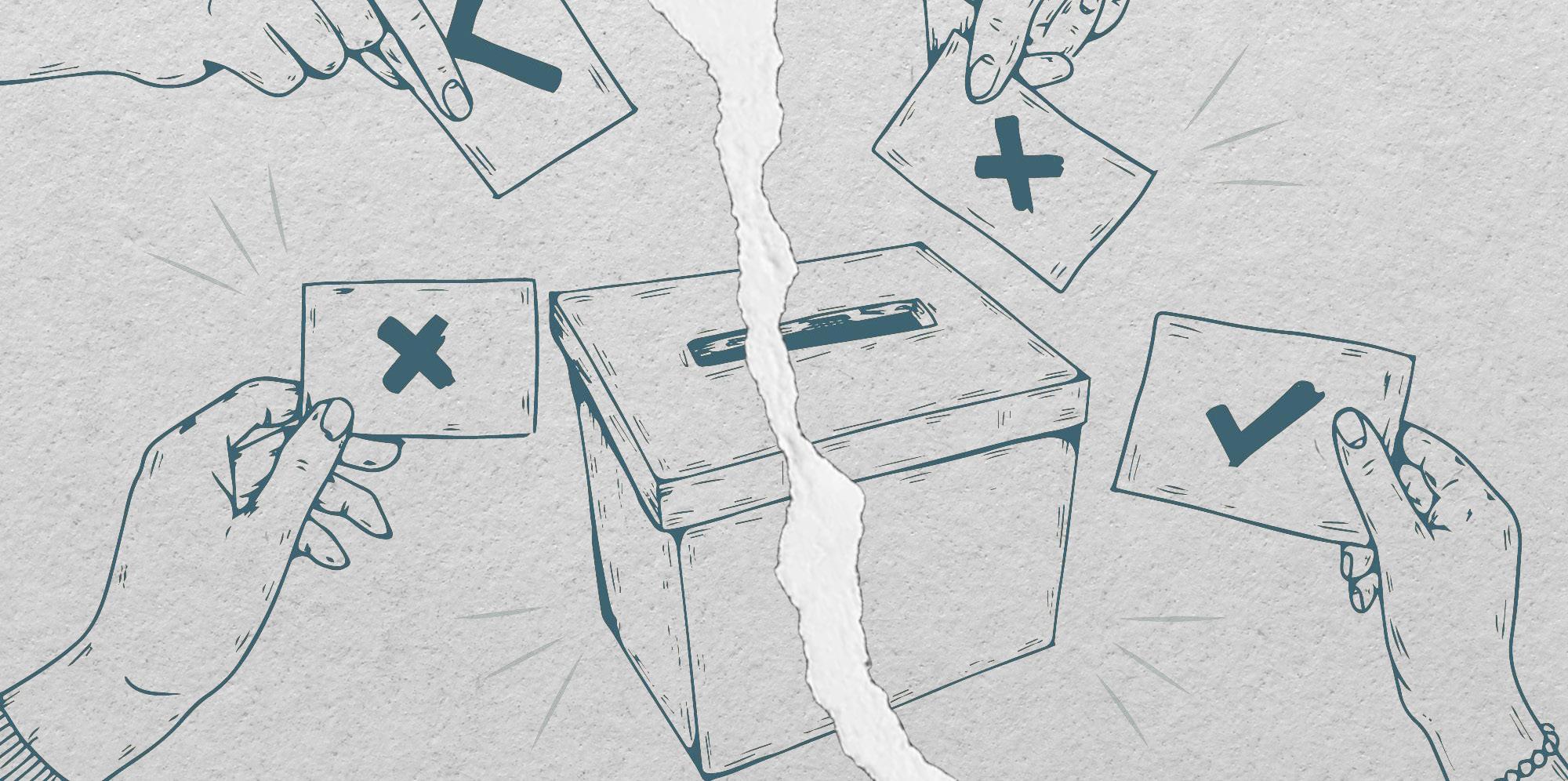
I’ve always looked forward to voting. Now I’m not so sure.
The 2024 presidential candidates have left me disillusioned with who to submit my ballot for
By Isabella X.I turn 18 in October. Just in time for the 2024 presidential election.
It always felt like fate that one of my first actions as a fully-fledged, legally certified adult would be to vote.
In the last four years, I’ve spent countless hours dialing random numbers, reading off a script: “Hello [insert voter name, read off a file, here], this is Isabella X., calling from the California Democratic Party. This election is a crucial time to make your voice heard, and there’s no better way than to vote.”
Change, in my mind, was best enacted through a #2 pencil bubbling in a candidate’s name on the ballot. It felt criminal to waste my vote. I remembered watching the 2016 election, watching helplessly as Trump garnered the support of more and more states. I was disgusted when I learned that only 59.2 percent of the voting-eligible population had participated. How could anyone feel apathy toward policy decisions that affect us all? How could anyone abandon this responsibility?
I think I understand them better now.
As I read more about each candidate’s positions in preparation to submit my ballot, it didn’t seem as black-and-white
as 4th-grade Izzy believed.
The two options available to me—Joe Biden and Donald Trump—are more than disappointing. They’ve both made foreign policy decisions that I find reprehensible.
When I voice these concerns, people tell me Biden is the “lesser evil.” What is “the lesser evil?”
The “lesser evil” feeds on the promise that each compromise will be the last. Nevermind the limbs scattered across its den. The lesser evil is, ultimately, still evil. And I can’t in good conscience use my vote to advocate for that.
Some voters have found a potential solution: voting undeclared. During the Democratic primaries in late February, activists encouraged Michigan democrats to not vote for Biden and instead check the box “uncommitted.” More than 100,000 voters did just that.
While the protest posed little actual threat to Biden’s chances as the Democratic candidate, it did send a clear message to the current President: that voters aligned with the values of the Democratic party, but not of Biden. These kinds of protests have to potential to enact tangible change—it’s a step above feeling “uncomfortable” with your vote, and instead using that ballot to send a message that you don’t agree with the candidate’s policies.
Another option is to turn toward a third party’s candidate. But this action is heavily criticized, as supporting any third party in a two-party system risks “splitting the vote.” Is the cynicism sinking in yet? Is the only option really to vote for the lesser evil?
In the presidential election—yes. But in our overall democracy—maybe not. With all the focus on the big Trump versus Biden showdown, it’s easy to forget that they’re not the only members at play in our government. Elections for the California House and Senate are coming up in early November, and are another opportunity to elect a candidate who will create meaningful legislation. The last few years are a testament to how useless a president is if not backed by Congress. And when presidential elections roll around in another four years, you can be sure that I’ll be voting for a delegate to attend the 2028 primaries.
Still, the “lesser evil” reasoning is prevalent for a reason. I’ll likely still cast my vote for Biden, but it won’t be without a heavy heart and increased disappointment in our voting system. I’m disillusioned, sure, but that only makes me more deliberate in contributing to our democracy.
Our environment promotes STEM based careers—but what about everyone else?
By Neel G.“I want to be a neurosurgeon,” I asserted in an interview when applying to Nueva back in 7th grade. I was confident in my answer: I thought it showed intelligence and high standards, while implying a strong work ethic. I elaborated with my go-to reasoning: “Learning more about the interesting complexities of the brain while helping people just seems like a dream career.” But that was a lie; the real inspiration behind my answer was from a quick Google search of the most prestigious, money making medical profession—along with a deep-rooted pressure to excel in STEM.
I never had a real interest in medicine or STEM-related fields, but since I was six, I’ve felt a mounting pressure to become a doctor as an adult.
As a second-generation Asian American student in Silicon Valley, the financial and intellectual standards are high; seeing as I didn't particularly enjoy math or engineering, and never had any inclination for computer science, I hastily decided on medicine as the only logical career path. It wasn’t until high school that I considered non-STEM related subjects worthy of pursuing. When I was convinced by one of my friends to take a creative writing class this year, I realized my passion for writing; and from my history classes, I found my love for social studies.
As I reflect on my past, I understand
that my prejudice against non-STEM subjects was a result of values being placed in prestige and money from my environment. But as I got older, I began to recognize the skill and beauty of other subjects, and I celebrate those that have excelled in them.
Through finding how non-STEM careers can indeed be successful, and the respectable skill needed for those careers, I challenged the thought processes ingrained into my mind as a child. But most impactfully, I redefined what success looks like to me: rather than prioritizing income or prestige, success meant to allow one’s passion to drive whatever amount of financial stability or prestige they personally desired.
Unfortunately, I’ve found that mentalities similar to the one I held as a child are prevalent within our student body.
In discussions with classmates about future careers where I mention my aspirations in literature or history, I am often retorted with concerns about my future financial stability or my parent’s opinions on my passions.
During a recent conversation about summer plans, peers eagerly praised those with NASA internships or biology research spots. However, upon sharing that I would possibly work at a local newspaper, I received only an insincere smile and a nod.
As a result, I’ve faced a burdening pressure from other students to place out of lower math levels through taking booster classes or enroll in outside-ofschool science classes, despite my lack of interest.
Throughout my time at Nueva, I’ve seen how our student culture synonymizes “smart kids” with those who excel in STEM.
With a changed view on our definition of intelligence, I hope our community can better foster and recognize non-STEM potential in our students.

 By Senior Editors of The Current
By Senior Editors of The Current
Dear readers,
We, the senior editors of The Nueva Current, feel like we know a little bit of our parents' pain.
We’ve helped raise The Current, nurturing it through difficult times. We’ve seen it win awards (and miss out on some, too). We have spent countless hours writing, editing, and designing; we have given it our all.
Now, just like our parents this fall, we are letting go.
The Nueva Current has been a conduit for all of our collective passions, interests, and other worldly events. Whether we’ve spent two or four years writing for The Current, each of us has seen the power of civic discourse that this newspaper possesses, and we are excited to see what it continues to produce.
But, like a parent, we worry and we fear.
We worry that as the future editors and staff writers continue on the road we helped pave, some of our shortcomings might crack and fissure.
One misstep we took this year was in our coverage, or lack thereof, of the war in Israel and Palestine and its impact on our community members.
Last year, when the war in Ukraine broke out, we dedicated entire pages to various angles of coverage. We highlighted the political ripples it would have, the community members who were affected, and the tragedy of war. We felt that we were not shy with our reporting and our voices.
But, in contrast, we have shied away from covering this most recent war. At first, we sought out perspectives from teachers and students outside our staff but discovered that our community members were similarly reluctant to have their names attached to any article about the war between Israel and Hamas.
We feared inadequately covering the story would do more harm, so we never directly covered it at all. As student journalists, we acknowledge this as a failure to address a deeply complex issue. When we covered our Issue 4 story on student activism, when our student stand-off considered whether schools should release public statements in response to major world events in Issue 2, and when we addressed free speech in that same issue—we were approaching indirectly and from the sides.
To our community and readers, we invite you to strive towards open dialogue. The Current can only fulfill its purpose of serving its community when students and faculty feel comfortable sharing their opinions on such a public platform.
To our incoming Editorial Board and staff, we are confident that you will continue to pursue fearless coverage, serve the community, and acknowledge any missteps along the way. As the class of 2024 leaves The Current and finds another wave to ride, we hope whatever positive impacts we’ve had will remain and that any of our errors can be learned from. And as we continue to grow as journalists in college and beyond, we’ll take the missteps we learned from this year to heart—to write without fear.
Best, Aaron H. Ellie K. Isabella X. Owen Y-L
Recognizing the strengths and failures of The Current under our guidance Meet the 2024-2025 Editorial Board: Editor-in-Chief: Josie B. ’25
Managing Editor: Natalie L. ’25
News Editor: Alvin Y. ’26
Culture Editor: Ellie L. ’26
Features Editor: Gabriel B. ’25 Opinion Editor: Kayla L. ’26
Sports Editor: Ethan H. ’25
Let’s combat period stigma in school bathrooms and beyond
By Kayla L.Screw TMI: Welcome to a girls’ bathroom at school. I am entering a stall, as I hear a purposely-muffled plastic crinkle. It’s someone opening a feminine hygiene product as slowly and as quietly as she can—a pad or tampon—and I can’t stand that she feels the need to hide it.
This moment is part of a bigger problem. Shame and stigma around menstruation at school and beyond are prevalent. Periods are still deemed as unclassy and meant to keep hush-hush. My message is simple: it’s 2024, and this is so yesterday!
But, at 11 years old, I got my first period and felt a regretfully similar pressure. It was like an unspoken rule to hide it, so I quickly mastered technique in concealing the ugly sin.
Tuck your tampon under your hoodie sleeve, change your hygiene products at strategic times to avoid suspicion, and never—NEVER!—talk about it too loud. That would be far too unsophisticated.
Even in girls’ bathrooms, I was ashamed and hid my period. Even though
some said the development made me a grown “woman,” it was hard to believe it.
On top of uncomfortable PMS symptoms, I subconsciously absorbed from other societal cues—for example, learning about menstruation in a very unempowered puberty ed class—that periods are scandalous, and meant that I was… nasty.
Looking back, I cringe at how anxiously

time quickly ripping open a pad; or how I dedicated five minutes to delicately opening my tampons. I wish I could tell young Kayla that there was nothing to be ashamed of, despite what anyone else said. I’ve realized that there are so many people out there who know what it’s like. According to a study completed last year, about 1.8 billion people across the world menstruate every month. Thus, on any given day, 800 million women and girls are menstruating, making up 26% of the global population. (Not quite half— menstruation does not occur a woman’s entire lifetime.)
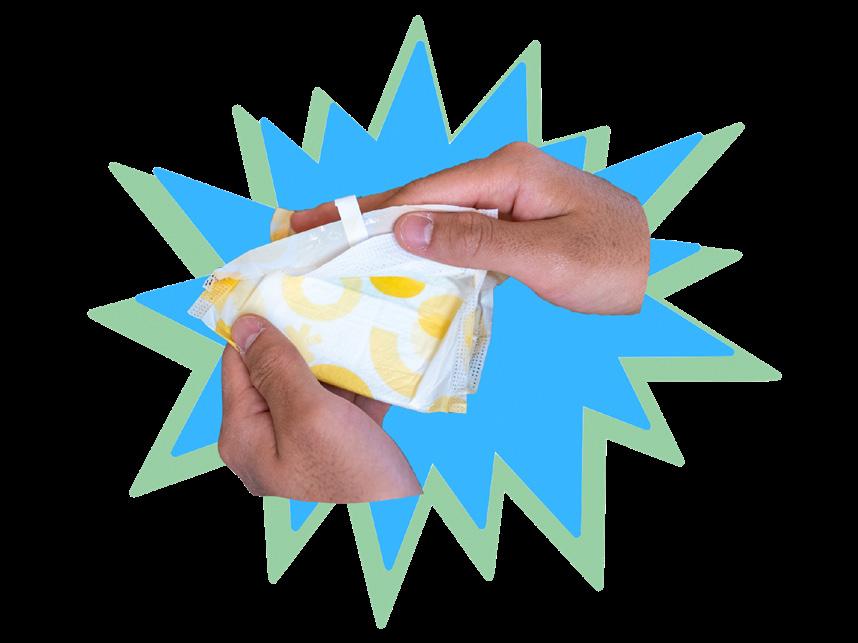
As such, the stigma surrounding periods has affected, affects, or will affect millions of people. It manifests itself in small ways that start to hurt. I feel it when you roll your eyes and say, “It must be that time of the month for her!” It weighs on my shoulders when you grimace as I complain to my friends
of cramps. It gnaws at me when you give me dirty looks for buying tampons at Safeway. The more I think about it, though, I how unnecessary and unproductive period shame is. Without sounding too textbook, it is a natural biological process. Additionally, many women who experience periods already feel physical pain or discomfort; in fact, limited research shows that it can get as extreme as a heart attack. Since we’re expected to go on with our lives like normal—some advertisements even advise horseback riding, IYKYK—adding emotional or mental stress to our existing pain is avoidable and necessary.
In the face of period stigma, I call on all of us to collectively combat it. It starts with you: Never shame or judge people who get periods, and instead seek ways to uplift them. Most of all, for my friends and peers experiencing periods, please know that in womens’ restrooms there is no need to hide your period—or yourself. Rip that pad or tampon open with pride!



In less than a week, we’ll be graduating. As we indulged in the sweet, sweet taste of senior spring, we couldn’t help but reminisce about our time at Nueva. Although we’ve explored different academic paths, we’ve both determined that Nueva is what you make of it. Before we bookend this chapter of our lives, we’d like to impart some lessons. We hope it also helps you find meaning here.
1) Take advantage of physical resources and facilities.
Every corner you turn at Nueva, there are resources and infrastructure that you would never find at a regular high school. The I-Lab, where my friends and I made our prom corsages; the art room, where I became a prolific pinch-potter; the infamous green couches, where our entire senior grade lounges and studies. Over the fall semester, when I discovered that I was physically incapable of writing college applications in my own house, I stayed at the green couches or the WRC until 9 p.m. almost every day. Some of my fondest memories were made Doordashing Nick the Greek to share with my Green Couches family, spending a few hours reading a philosophy comic book in the WRC, and mixing the right shade of “Pitbull” to paint a swim cap in the art room. Nueva has the resources; you just have to discover them.
2) They were right: don’t overlook social-emotional learning.
You may have come from the Middle School, where you took SEL (socialemotional learning) classes. Or, you may be new to Nueva, and find yourself wondering why SOM (Science of Mind) is emphasized so much in the curriculum. You may not realize it now, but it’s one of the most
“With their SEL toolkit, [our alumni] have been able to confidently navigate social situations, connect with individuals…, and positively resolve disagreements. For younger alumni, they are immensely grateful for that [SOM] piece of their Nueva education."
—Diana Chamorro, Director of Alumni and Community Engagementunderrated skills that Nueva attempts to instill in us. Learning how to express your feelings through “I” statements may seem like only a trivial exercise in class, but outside the classroom, it’ll help you

navigate conflicts with your parents, peers, and employers and become a better part of any community. Don’t underestimate the importance of SEL and SOM—better yet, find opportunities to exercise it outside of class. Learning how to be emotionally intelligent gets you further in life than any technical skill or knowledge.
3) Shift your mindset about “success” in high school.
Many students (and more often, parents) see high school simply as a stepping stone to getting into college. Such a pre-professional mindset has pushed 13-year-olds to feel the need to build a “brand” for themselves, at the expense of personal exploration and discovery. Consider this: if you set your mind to achieving a standard of “success” (e.g. getting into a top college) and don’t reach it, you will feel like all your years of hard work have gone to waste. But if you reframe your mindset and see the hard work as a process, you will realize that you never really lost anything. Yes, do things for your future self— don’t be a “bum”—but don’t lose sight of your present self and its needs. Have fun. Live. Take care of yourself. You need to get to the future first to have a future.
4) Resist the temptation to base relationships solely on gossip.
“Oh did you hear…” “Did you see…” Sound familiar? In such a small community, it’s easy to find conversation in gossip where each student inevitably has at most a twodegree connection to the subject of the discussion. Gossip serves its purpose—it’s a form of information seeking and retrieval, and strengthens “in-group” and “out-group” lines—but friendships built solely off of discussing others do not stand the passage of time. Deep relationships go beyond talking about other people—there’s so much value to be gained from getting to know people for who they are. Take a risk and share something about yourself with someone you trust that makes you vulnerable—that’s where the deeper, lifelong friendship lies.
5) Talk to your teachers. Attend another school, and you’ll find equally qualified, perhaps even equally passionate teachers as Nueva’s. But almost everywhere, there simply isn’t enough of one resource to go around: time. At Nueva, tutorial time—or office hours—is built into the school day, which means you have the privilege of your teachers’ time. When I bombed my Prueba 2 (second Spanish test), I scheduled a tutorial. When I got stuck on my chi-square test…tutorial. When I diagnosed myself as a serial procrastinator…you get it, tutorial. When you do talk to your teachers, remember that they are so much more than the people giving you a grade. They have rich life experiences and multifaceted worldviews that translate into wild stories and wise advice. Who knew I’d get dating advice from the Dean of Students or talk Parisian fashion with my math teacher? Remember, too, that habits matter. One tutorial may solve your immediate concerns, but making it a habit will cultivate a mindset of continuous growth. Be proactive (without exploiting your teachers, of course), and the skill will serve you in college and beyond.
6) Make bold choices. My grade size is smaller than the number of Xtra Cheddar Goldfish I can devour in a sitting, which made me think I knew everything about everyone. But senior spring taught me that there are so many friendships waiting to bloom. Reach out first, and across friend groups, grades, and other superficial categories. Be bold in your academic life, too. Nueva is not a trade school; it isn’t preparing you to get a job the moment you graduate for which your courses are immediately pertinent. Meaning, you can take courses that don’t fit one neat, niche path. Nueva is the place to broaden your mind and safely fail at a variety of pursuits (a sentiment that my one semester of Yearbook Media Production in Freshman Fall exemplifies). School should make your mind a better place to live in.
“Being publicly wrong is so much more valuable than being privately right. It doesn’t matter that we know economics... or a particular interpretation of The Tempest. What matters is our capacity to think and learn.”
7) Develop a healthy relationship with deadlines. At Nueva, extensions and retests are easy to come by. When large assignments culminate, that flexibility is tempting to exploit. Because there are no real consequences to procrastination at Nueva, it’s a habit I’ll sheepishly admit I developed. It was only through respecting deadlines that I realized how much mental energy went to anxiety and avoidance that I could’ve invested in learning instead. Turn in your assignments early when you can! Conversely, don’t become encumbered by deadlines. Requirements, rubrics, and deadlines (in fact, Nueva as a whole) are simply structures designed to inspire your growth and creativity. If you’d take a perfect GPA at the expense of learning, you’re at the wrong school. Instead, capitalize on Nueva’s pedagogy to discover how and why you learn.
8) Live authentically.
From the unsolicited opinions of friends to the crushing expectations of adults, it’s all too easy to assume an identity that isn’t your own. You wake up one day struggling to distinguish between societal constructs and your genuine essence. This dilemma often stems from the false binary between being liked and being real. Authenticity, however, is undeniably appealing. Although, to be frank, authenticity is easy to want to be, and hard to embody. I’m in the process of getting rid of the mindset that everyone is watching and judging. Nobody is that important. Personally, that’s an incredible relief. When I think about my test scores, friendships, and college decisions, I realize that the only constant in my life will be myself—the mind I inhabit. If I lived the rest of my life inauthentically, I

Aaron H. ’24 Editor-in-Chief
Ellie K. ’24
Isabella X. ’24
Managing Editors
Natalie L. ’25
News Editor
Owen Y-L. ’24
Features Editor
Josie B. ’25
Culture Editor
LiAnn Yim
Faculty Advisor
STAFF
Gabe A. ’24
Gabriel B. ’25
Jordan F. ’27
Neel G. ’27
Gabe H. ’24
Jackson H. ’26
Ethan H. ’25
Niam K. ’26
Milo K. ’24
Ellie L. ’26
Kayla L. ’26
Roan W. ’24
Alvin Y. ’26
THE NUEVA CURRENT strives to provide informative and impactful articles for our community. Our issues cover stories related to our school, the Bay Area, California, and other relevant spheres. We are dedicated to helping readers understand the ways in which we can all make a difference in the world around us.
The opinions expressed in The Nueva Current belong solely to the writers and are not a reflection or representation of the opinions of the school or administrators.
The Nueva Current is distributed to current and alumni members of The Nueva School community. Press run is 600 copies.
The Nueva Current is a member of the NSPA and CSPA. NSPA Pacemaker Finalist 2020, 2022, 2023. Pacemaker Winner 2022. Gold Crown winner 2023.
QUESTIONS, COMMENTS, SUBMISSIONS
We welcome your voices. We accept photographs, letters to the editors, articles, illustrations, and other pieces of work. Please email us at thenuevacurrent@ nuevaschool.org.
STAY CONNECTED
www.thenuevacurrent.com
Instagram: @thenuevacurrent
Twitter: @thenuevacurrent
131 E. 28th Ave.
San Mateo, CA 94403
I was 1/8 of the Black student population this year. This is my lived experience.
By Gabe H.When I entered the Nueva community after moving across the country in tenth grade, the Black Student Union (BSU) provided refuge and sanctuary during my difficult transition. On Thursday afternoons, Black students and employees came together in room 345 to share updates about our personal lives, exchange updates about Black culture, and plan field trips. Most centrally, though, we bore witness to the joys and growing pains of attending Nueva with the intersectionalities of our identities at play. Though I was one of only 11 Black students at the time, in those short BSU windows, I felt moments of respite that I rarely found elsewhere at Nueva. I never felt marginalized.
However, this feeling of racial affinity was finite. At the end of tenth grade, our then-Equity & Inclusion Coordinator who also served as the advisor of the BSU departed Nueva, and the BSU began to lack organizational structure. We met a couple of times at the beginning of my eleventh grade, but without a dedicated room and consistent schedule, meetings fizzled out and ended completely before Thanksgiving break. By then, I was one of only seven Black students in the entire Upper School and one of three in my grade.
In my sophomore year, I was mistakenly called by the names of the other Black male students—even by adults and friends. Recently, I was mistaken for the other Black maleidentifying student in my grade by
a faculty member with whom I interface regularly. I’m still misnamed occasionally, and to say it doesn’t sting would be fallacious.
As I hear from Black students at other private schools, I can’t escape the feelings of envy. Lick-Wilmerding, a private school in San Francisco, has 70 Black-identified students enrolled (which makes up 12.7% of their student body) and retains an average BSU membership of 40 students. By contrast, Nueva’s Upper School has eight Black-identified students enrolled, which makes up 1.7% of our student body. While Lick is in San Francisco County, where the percentage of Black residents
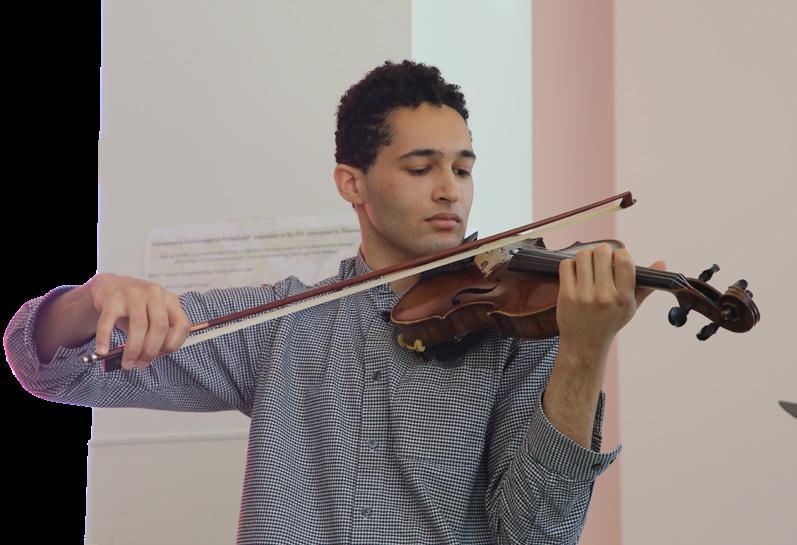 Photo by Gabe H.
Photo by Gabe H.
There have been a disheartening amount of times where I’ve forfeited my friends to wait in room 215 for other students and faculty to join our meeting, only to have no one show up at all. If we had more Black students at the Upper School, we could have a vibrant and thriving BSU.
is more than double that of San Mateo County, according to the United States Census Bureau, Nueva should, by that math, have at least 27 Black-identified students in the Upper School. That has not been the case during my time at
We must acknowledge the gifts that support our academic success
By Ellie K.What does it mean to attend a school for gifted learners? Accelerated math tracks. English books often reserved for college students. National titles in debate and physics. But what lays the foundation for that kind of learning to take place?
Privilege. Opportunity. Curious minds collaborating for a greater future.
Academically, I’ve never considered myself gifted. During freshman year I was more versed in imposter syndrome than foreign languages or mathematical theorems. But I knew I was lucky to be surrounded by such high-achieving and curious students, peers who were unafraid to ask questions and immerse themselves in their intellectual endeavors. Here, being intelligent and having academic pursuits are admirable, and I am grateful for that.
At Nueva, it's hard to overlook the academic excellence of the student body. Parents, teachers, and administrators frequently remind us of our achievements. We’re described as “gifted,” praised for our unique thinking, and recognized for being “above average” in the classroom.
But if I were to leave behind a piece of advice for current and future students, it would be this: I implore you for a moment to reframe your giftedness not as your academic caliber but as the gifts you’ve received that enabled your success.
I believe my peers do not sufficiently recognize the gifts bestowed upon us by our families and the community. We are gifted, yes in the sense that this institution
defines, but more significantly in the sense that we have privileges inaccessible to most teenagers.
To name just a few: The work done by their parents to afford tuition; the efforts made by faculty members to offer diverse classes and ensure scheduling runs smoothly; the additional hours dedicated by teachers to provide exemplars, tutorial meetings, and personalized feedback; the attempts by community members to build and preserve a beloved community, one with forgiveness and understanding at its core.
I implore you for a moment to reframe your giftedness not as your academic caliber but as the gifts you’ve received that enabled your success.
Nueva is not perfect, I’m aware. But I believe the community would do better to rid itself of its air of entitlement, or the assumption that “I am gifted, so I deserve these gifts as my due.” Instead, we must reframe this belief to express gratitude for everyone who provides these opportunities for us.
I appreciate the phrase, “to whom much is given, much is expected.” I hope that Nueva students—with their extensive opportunities, resources, and academic and SEL foundations—will do great things beyond high school. I encourage the
With only eight Black students on campus and a plethora of other programming during our dedicated Wednesday lunch blocks, it has been hard to co-lead BSU with an eye towards retaining weekly participation. I’ve heard from affinity group leaders with groups of larger enrollments that it’s not been quite as difficult for them. There have been a disheartening amount of times where I’ve forfeited my friends to wait in room 215 for other students and faculty to join our meeting, only to have no one show up at all. If we had more Black students at the Upper School, we could have a vibrant and thriving BSU.
The recent news about the adjustments to financial assistance is giving me hope. Perhaps this is what the school needs to increase both broadly its student of color population and specifically its Black student population. I hope that a financial decision like this will lead to a more diverse student body.
As I reflect on my time at the Upper School, I’m singularly grateful for my Nueva experience, as I have gained lifelong friends and a high-quality education. As I graduate, my hope is that four years from now, there isn’t another Black student at Nueva who feels the need to write a similar piece.

by
community to acknowledge and appreciate their gifts—both those coming from inside and out—and use their privilege and knowledge to make the world a better place.
We learn how to engage in civil discourse, stand up for what we believe in, think critically, and grow from mistakes. We are taught how to grapple with complex emotions, validate diverse perspectives, work hard, and care for each other. Those lessons coupled with our resources and support systems pave the way for us to become changemakers and positive contributors to the world. We might not have handholding, but the path certainly has handrails, signage, and a clear course. We just need to take the first step. We have been given so much and have an obligation to give back; through academic exploration, stewardship, social betterment, or leadership, it’s imperative that we use our gifts wisely and for something beyond ourselves.
With our education, work ethic, and the dozens of individuals cheering us on, we have a responsibility to use our minds and hearts for good. It’s a gift to do so.







This year, StuCo introduced the first-ever prom court contest. Juniors and seniors can nominate their classmates, then vote for two winners per grade, who are crowned at Prom. Two students weigh in on the new tradition.
Let’s expand prom court to its full potential, beyond a vague popularity contest
By Owen Y-L.Nueva has always aimed to be a far cry from the high school experience depicted in movies and TV shows—and we’ve proudly embraced that. Instead of a football team and cheerleading squad, we celebrate our debaters and Science Friday presenters. We refer to our teachers by their first names. To the best of our abilities, Nueva has emphasized inclusion over tradition. Still, Nueva isn’t immune to the traditional social dynamics of high school—we have our cliques, drama, and controversial group chats. By introducing a conventional prom court contest, I worry that we could inadvertently exacerbate these divisions.
It’s a tricky line to walk, I admit: How can we retain the spirit of an old-fashioned tradition while also not falling into regressive, old-fashioned dynamics? While I appreciate the inclusivity of expanding beyond Prom King and Prom Queen, I believe prom court has the potential to be so much more than a mere popularity contest—a platform to celebrate the diverse talents and contributions of our student body. Popularity contests aren’t necessarily the problem; we already vote for our peers in various ways. Our student council, StuCo, is one example of how student democracy can be used to select candidates who we feel will represent and work for us. While bias and superficiality certainly exist in the StuCo process, it is at least partially based on merit and experience. The problem with prom court is that, unlike StuCo elections, there are no campaign promises, track records, or even welldesigned Canva posters to vote on—it is purely a game of popularity and inside jokes.
I’m also not saying that we shouldn’t celebrate our peers at prom. In fact, to the contrary, I believe that we should
expand prom court to highlight even more of our community’s talents. Limiting the contest to only two individuals per grade without any real criteria is too nebulous to be meaningful.
This year, I recall staring blankly at the nomination form: What qualities does the ideal prom court appointee possess? Should I select an existing couple or two separate people? If I’m nominating my friends, which two should I choose? Confused, I didn’t end up filling out the form at all. I even spoke with someone who was elected to prom court this year; they observed that the process felt random and “anti-climactic.”
I acknowledge that this is the contest’s first trial run at Nueva, and that it will certainly be refined and revamped in future years. And I truly appreciate StuCo’s efforts to promote school spirit (which we as a community tend to lack) through new traditions.
One simple remedy is to expand the prom court ballot with more specific awards. “Best Dressed” and similar shoutouts are already an informal prom tradition. Let’s invite the entire community to vote on those awards to facilitate community bonding and encourage spirit. This would still allow us to recognize spirited individuals, while also diversifying beyond boring social hierarchies.
After watching the recent Mean Girls movie musical, I was reminded of just how untraditional Nueva is, both academically and socially—for the better. Even so, I believe we could all take a bit of Cady Heron’s wisdom to heart when evaluating prom court. As she declares after accepting the Prom Queen crown during the movie’s finale: “It’s just plastic. We could really just share it.”
Give prom court its time in the spotlight
Prom court is an opportunity to infuse Nueva dances with more fun and excitement
By Milo K.Nueva has a communal fun problem. While StuCo has made strides with spirit assemblies and games like Blammo, there is still a significant lack of engagement or effort put out by students for nonacademic endeavors. We have no Friday night football games, most spirit week outfits are just jackets and jeans, and halls seem to immediately empty at 3:10. While not the perfect solution, voting and campaigning for prom court can bring more engagement and celebration within our community.
Nueva students, in general, are very future-driven. It feels like every poster I see, or student organization I am emailed about, is a resume booster. I think this culture has many benefits— I have been inspired and motivated to aim higher based on seeing what my peers are doing. However, in this culture, the typical high school activities have fallen to the wayside. The dances in particular feel to suffer the most. Attendance is spotty, and even when people show up, they scatter to corners and chat with friends.
The concerns about the traditional prom king and queen are valid. It is largely a popularity contest—in media it’s always the jocks and “mean girls” that win—and the sting of losing can dampen what is supposed to be a special night. However, in the current Nueva landscape, where a unifying moment of fun is desperately needed, the typical Prom Court system is a necessary stepping stone to reinfuse Nueva dances with the
CORRECTIONS: The Nueva Current welcomes comments and suggestions. We seek to publish corrections and clarifications in the subsequent issue.
Please email any corrections to thenuevacurrent@nuevaschool.org.
Corrections for Issue 5, published April 8, 2024: On pg. 16, the Connections word "print" should have been labeled as "hack."
festivities they lack. Currently, prom at Nueva tends to feel less like a culmination and more like a slightly elevated dance. While we go to another venue and dress up, it lacks the glamorous and closure Prom should have. Prom court, a system designed to celebrate members of the community, can bring some typical prom luster to Nueva, making the night all the more special.
Nueva’s community is not the norm. We foster a welcoming and supportive environment. This is not through refraining from typical high school activities, but rather through the small classes sizes, collaborative culture, and collective celebrations. We stray from the high school stereotypes of jocks, nerds, geeks, and rebels. As seen this year, there is no one group of people that will win every year—winners can, and will, be from diverse friend groups. While other, more competitive, larger schools might struggle to implement the celebration, Nueva’s community is in the perfect position to celebrate the crowned, rather than resent.
Additionally, for the victors and their voters, the crown and sash are a signifier of a cumulative celebration. It means more than the plastic it is made of, it is a moment of recognition, a celebration of who they are as a person, as a friend, and as a community member. In five years, memories of our night will fade into moments of joy-coated nostalgia; for prom royalty and their voters, the recognition is a glowing capstone in a cluster of high school emotions.

From drama to stress, we've got advice for you!
By Ellie L.I think my parents are heading for a divorce. At this point, they've just accepted it, but I haven't. It's just really hard.
— Sad in San Francisco
First off, I’m sorry that you’re going through this. It’s a tough situation, and no one is at fault here. Please remember that as you process the divorce, especially for yourself. It is not your fault, it does not fall on you to fix their marriage whatsoever, and it is okay for you to want space and time to process.
Let yourself take some time to yourself. Maybe you don’t feel ready to open up yet, so try writing things down, or expressing your feelings through art, music—any kind of creative medium. Spend some time doing something you love and let your mind drift.
When you’re ready to talk about it, lean on your friends and family. Not everyone will understand, but an ear to listen is never a harm.
You can still make plans with your parents and have fun with them. Maybe that fun will turn into some important conversations, maybe it’ll just stay as fun. Both are valuable. Finally, know that your acceptance won’t come easily, and that’s natural. There will be times when all seems assured, and there will be times when you simply want to Trust that everything will resolve, eventually. Maybe not in the way you’re hoping for, but it will. Because people grow over time, and sometimes that means people grow apart. And that’s okay.
1. Ewe said it
Makeup artists?
Like some singers
Diagonal mover
Touching
Purr-son who loves
pets?
Utah's lily
Second prime
Jury members
Joyful shout
Commercials
It's out of 1600
Apple platform
Enemy
Poet Angelou
Male delivery
The "A" of MoMA
Enjoy the rink
Have another go at
___ Baba
Atty.'s title
Blood fluids
Hot dog holder
Mex. neighbor
Be into
Early bird?
Construction girder
High-five sounds
Expensive
Sensible
Common recyclable
Zealous supporter
Neighbor of 10-Across
Pre-calc course
For each puzzle, find groups of four words that share a common link!
Watch out for words that could belong in multiple categories.
Ex: “Pixar movies” (Brave, Cars, Coco, Up) or “___ button” (Belly, Hot, Panic, Snooze)




1. Jerry's partner
2. Small batteries
3. Toward the stern
4. Bottle size 5. Archipelago part 6. "So that's it!"
7. Fishing pole
8. Secret agent
9. Shoebox project
10. Unadorned 11. Nile reptile 12. "___ whiz!"
13. Gets older
14. Game played with the highlighted words?
16. However, informally 18. Condition 19. "Homeland" org.
20. A long way off 21. "Finding Nemo" character with her own movie 22. Complete collection 27. Thumbs-up
29. Mine find 30. Geeky-sounding candy 32. Slimy crawler 33. Mattress option 35. Dog's show of excitement 36. Presidential nickname 38. "We Will Rock You" band 39. Uncle ___ 42. Deplete 44. Way of walking








Busy co. on Mother's
"Midsommar" director
Puppy's bite




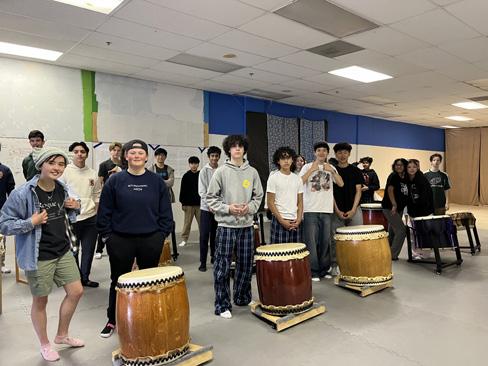



Best memory: “Getting to cook with people I haven’t before was one of the most fun experiences of the trip. We worked as a team and in the end produced the best taco night!!” —Chloe L. ’25
“Overall, our time with Tidelines has taught us to be not only more conscious about the environment, but also of the people and communities that have come before us.” —Marcus H. ’25 & Vivi L. ’25
Best memory: “Snorkeling at a coral restoration site and Pickles Reef where many of us chose to free dive as well. There, we saw turtles, rays, lobsters, and fish of all kinds.” —Ethan H. ’25

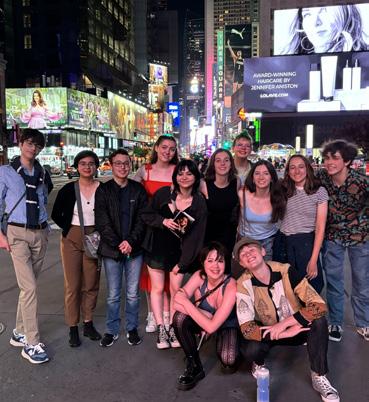




“We saw nature’s beauty in waterfalls and sun soaked beaches, and also urban beauty in Kaka‘ako murals, crowded Waikiki, and the Bishop Museum.” —Ellie L. ’26
Highlights: exploring sprawling team.Lab exhibits, seeing Sensō-ji temple, and making mouthwatering yakisoba.

Best memory: “Seeing various cool and unique species of fish while scuba diving.” —Charlie B. ’24
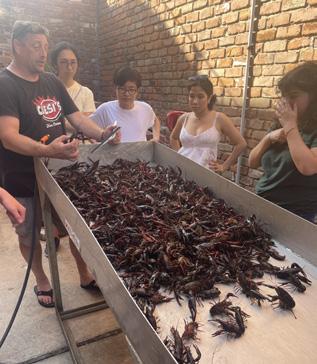

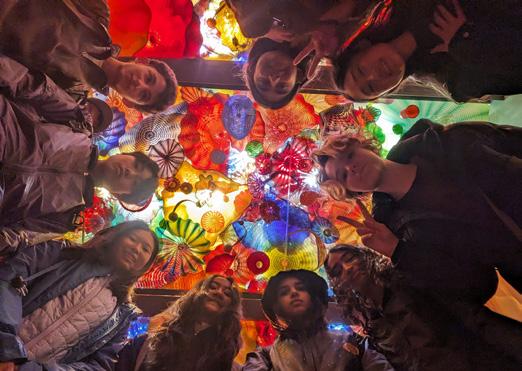
“Food is certainly a beating heart of New Orleans culture’” —Josie B. ’25, Natalie L. ’25, Charlotte S. ’25

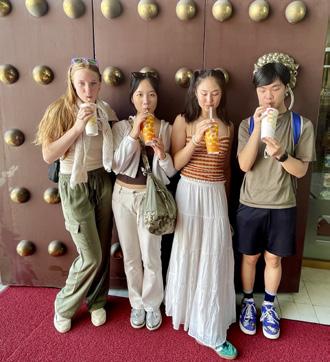


+ NEW YORK
Highlights: spotting orca whales, exploring the Chihuly glass garden, and touring Seattle’s underground


“Going to Hawaii taught me the importance of connection. With Highlights, favorite memories, and student reflections on the educational impact of their travel
Highlights: making and eating pineapple jelly, going to the top of Taipei 101, and exploring the night markets under strings of light!
Highlights: getting into the Schlesinger Library Archives, seeing over-a-century-old letters, and enjoying some classic New York pizza.
“It was such a gift to explore a new city with an wonderful group of peers and chaperones.” —Gabe H. ’24


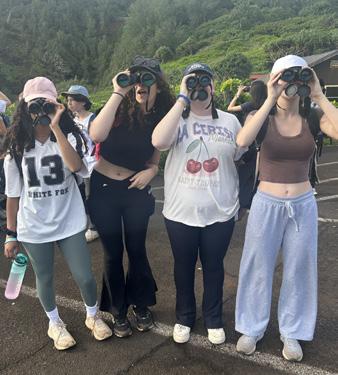

Highlights: Learning stories from Hawaiian culture, seeing turtles, cooking breakfast every morning, and mountain tubing KAUAI, HAWAI'I

“Atlanta was a wellspring for the Civil Rights Movement, and required less prodding to integrate relative to other Southern towns and cities. For me, it has been a fascinating place to tour and absorb history.” —Gabriel B. ’25
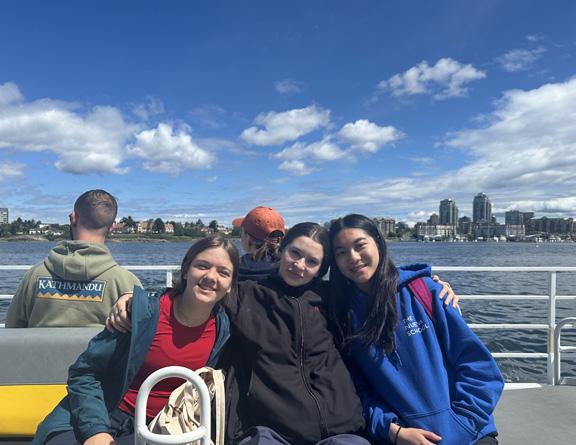
Best memory: “Once-in-a-lifetime experience seeing whales interact with each other in the wild.”


Highlights: conducting a census for turtles, drinking fresh coconut water, and studying all the natural flora and fauna.
Best memory: "Adorned in jewels, feathers, heels, or hats, [Tango] dancers moved with immense coordination—two people became one with rhythm and grace." — Ellie K. '24
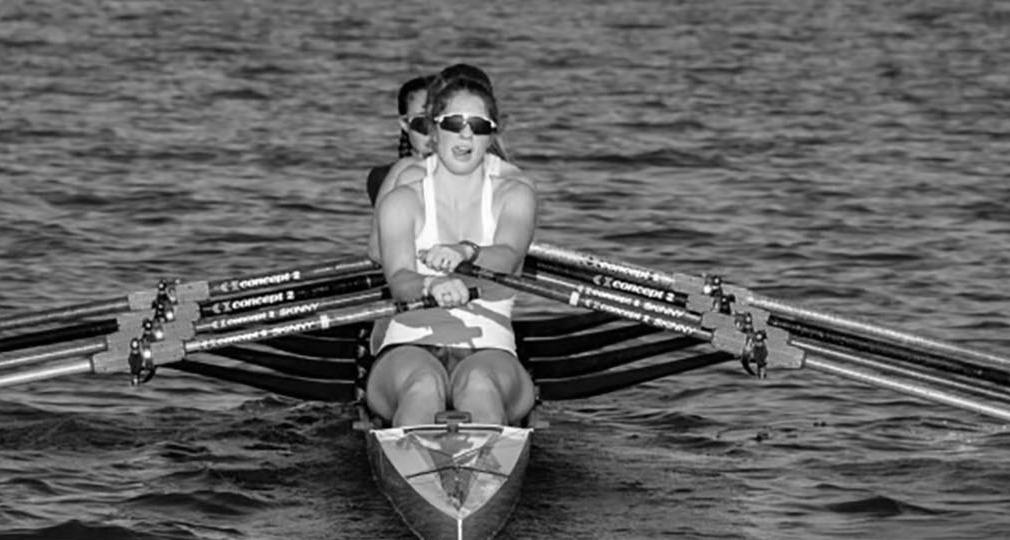



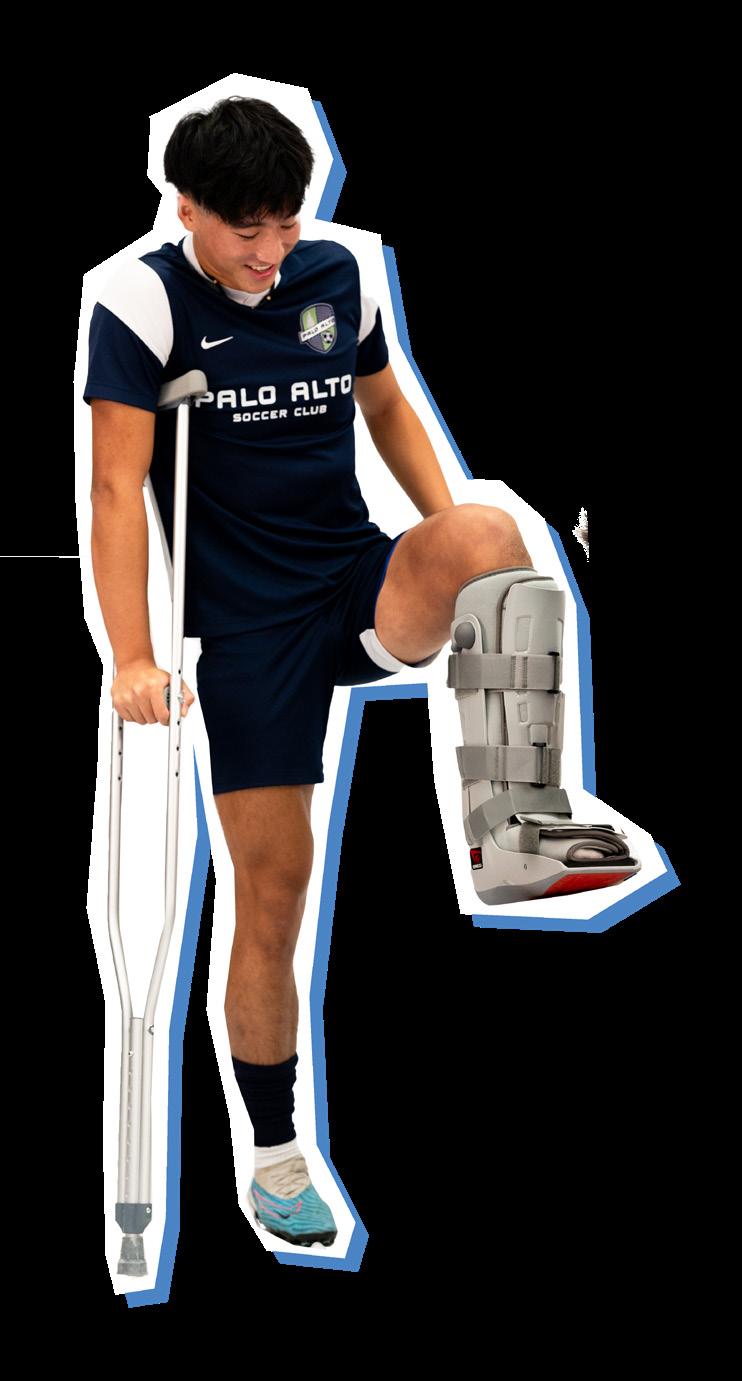
Sport: Soccer School: Pomona College Team Name: Sagehens
Gabe A.’s ’24 contribution to his club’s major success, perseverance through injury, and investment in the recruitment process earned him a spot on the Pomona-Pitzer Division III soccer team.
In junior year, Gabe and his Palo Alto Soccer Club team won the highly-regarded Surf College Cup in the fall, then the state championship at the end of the spring season, earning the team the number one rank in Northern California.
Throughout that title run, Gabe was battling a fractured ankle he suffered at the

Gabe C.
Sport: Baseball School: Amherst College Team Name: Mammoths
Without playing on a high school baseball team, Gabe C. ’24 was recruited to Amherst’s Division III team, a path largely unheard of for college ballplayers.
Gabe, an outfielder and right-handed pitcher, needed to play for multiple clubs on his own time in order to compensate for the high school opportunities he missed out on. He has played for Game Prep, Hit Club, Monarchs Baseball, and Bradley Baseball Academy.
Beyond his one of a kind story, Gabe's achievements on the diamond demonstrated

Sport: Gymnastics
School: Yale University Team Name: Bulldogs
A product of her standout ability and years of dedication, Ellie K. ’24 will be a Division I gymnast at Yale.
Ellie has been in the sport since age five and competed for the last 10 years with San Mateo Gymnastics. She was inspired to continue on beyond high school by the older girls at her gym.
Junior year, she became a highly ranked Level 10 gymnast, and qualified for nationals after tying for first in floor at the 2023 State Championships.

Sasha G.
Sport: Sailing School: Brown University Team Name: Bears
Sasha G. ’24 will carry her passion for sailing into college, having landed the opportunity to be on Brown’s team. Sasha first learned the sport at childhood summer camp, and has sailed competitively since the start of high school as part of the Peninsula Youth Sailing Foundation as well as with the Nueva club team that she founded. Her focus on sailing intensified junior year, and she has been able to place on podiums at regattas around the Bay Area.

These are the seniors that college coaches recruited to compete for their teams
By Gabriel B.
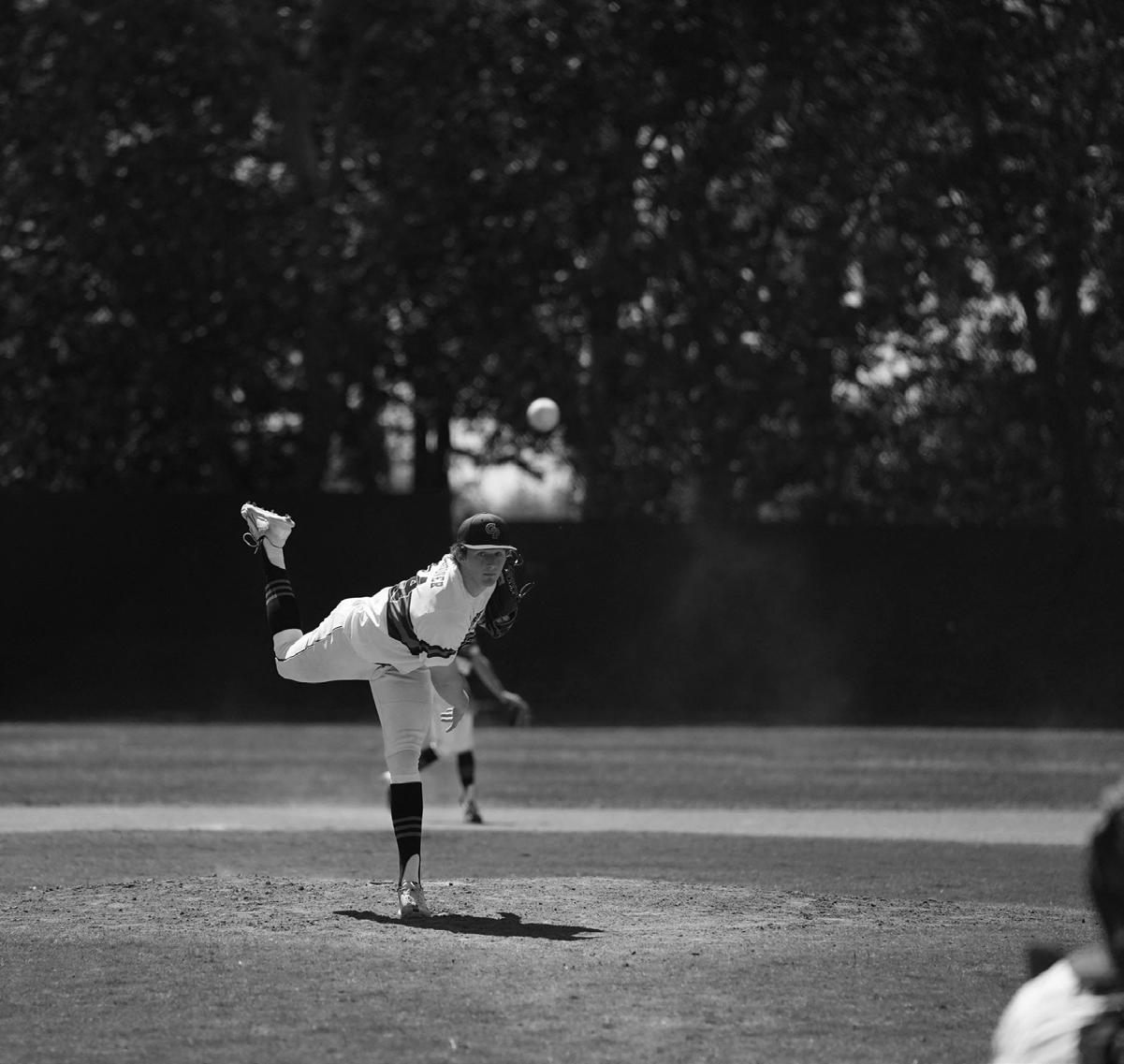
Surf College Cup. He opted to forgo surgery, manage the injury, and make sure he was available for his club team during their championship pursuit.
During the school year and over the summer, he flew out to showcase his ability to recruiters at a slew of talent “ID camps.”
Most consequentially, the Sagehens’ coach noticed the skills he displayed at the Pomona ID camp, which Gabe missed junior prom to attend.
Now he is ready to kick off another phase in his soccer career and tap further into his connection to the game he has played for nearly his whole life.
“That’s the main thing I’m excited about: playing the sport I love, training, and improving as a player,” he said.
his capability. He was a top prospect at the 2023 Sunshine West Showcase in Irvine hosted by Perfect Game, the leading baseball scouting organization. Perfect Game then selected him for its National Showcase in Phoenix, Arizona. Earlier in his junior year, he also participated in the World Power Showcase, a home run derby held at the Miami Marlins’ ballpark.
Competing at Amherst will be gratifying for Gabe. Teammates and coaches should invest in him far more than they did while he was hopping between clubs.
“I’m looking forward to finally being part of a team and actually being around guys who care about the sport as much as me, and having them be my friends in my circle at school,” he said.
Her impressive and consistently highscoring performances came under the pressure of increased recruiting attention. All the while, Ellie trained at summer camps on the East Coast to gain recognition, and for Yale, she visited campus and met the team.
Ellie views college gymnastics as a reward for making it through all her years at San Mateo.
“I'm excited to rekindle my love for the sport because my club experience has had many ups and downs,” she said.
She is looking forward to the fresh start that the college environment will provide.
“It’s known for being more uplifting and just an overall more positive experience to be an athlete and to be a member of the team,” Ellie said.
Sasha believes that her commitment, though, was what primarily interested college coaches. She sails six days a week, and at practices is “the first one to get there and the last one to leave.”
It was not until this February, however, that Sasha heard from the Brown sailing coach and officially received an offer to be on the team.
With her place now secured on the roster, Sasha feels a mix of apprehension and excitement about joining the team. She thinks it should calm the waters for her college transition, especially since she got to meet some of the current sailors over spring break.
“The community and the dedication,” she said, are what she looks forward to most.


the distinguished ECNL team still supplied a strong recruiting background.
She feels positive about what awaits with the MIT soccer team.
Zoe B. ’24 is committed to play soccer at MIT when the season gets underway this fall.
Zoe is currently on the ’06 Girls ECNL (Elite Clubs National League) team, the highest level at the MVLA (Mountain ViewLos Altos) soccer club.
Many players who came through the ECNL team in the past went on to play in college, and a number of Zoe's teammates had their sights set on joining the in-state women’s soccer powerhouses Stanford and UCLA.
Injuries have been a serious impediment to Zoe's ability to stay on the field during high school. In April she was coming off a half-year-long ankle injury, and prior to that

Sport: Rowing School: Dartmouth College Team Name: Big Green
After a rapid ascent in the sport, Taj D-J. ’24 will join Dartmouth’s NCAA Division I rowing team next season.
Taj began rowing in the fall of her junior year, and quickly drew attention after a couple months because of her ERG score, the time she clocked on a standardized rowing machine race. Her performance was not comparable to most recruits’, but given her limited experience, it revealed a level
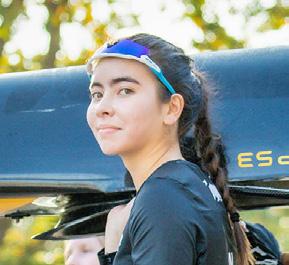
Reese G.
Sport: Rowing School: UCLA Team Name: Bruins
Reese G. ’24 has committed to row for UCLA after five years of experience at Norcal Crew in Redwood City.
The Bruins compete in Division I, and beginning next fall they will be members of the Big Ten Conference, which holds a major reputation for success in athletics. UCLA announced its move from the Pac-12 Conference in 2022, but has been waiting to
 Josie M.
Josie M.
Sport: Rowing School: Tufts University
Team Name: Jumbos
Josie M. ’24 overcame a journey of highs and lows over her high school rowing career and is now headed to Tufts to compete on what is currently the top-ranked rowing team in NCAA Division III.
As a sophomore, Josie began training six days a week for the varsity team at Norcal Crew in Redwood City.
She qualified for the 2022 USRowing Youth National Championships, but caught COVID leading up to the competition. She pressed on, kept training, and still raced in Sarasota, Florida at the start of summer. Pushing herself through the illness, however, took a
“I look forward to having a built-in family. That’s something I’ve heard from a lot of the players at the school,” Zoe said.
As the Athletics Rep on Nueva’s Student Council, Zoe wants future recruited athletes to get more support from the school, and has been working with the athletics department on the foundation for a better system. She organized a mock signing day to spotlight the seniors committed to college athletics.
“We’re trying to encourage more attention to the athletic community at Nueva,” Barton said.
of innate talent that sold coaches on her potential.
Since then, she has entered into prominent rowing events and raised her profile. She raced at Summer Nationals for the Potomac Boat Club and last October at the Head of the Charles Regatta in Boston with the Redwood Scullers.
Taj is upbeat about joining her soon-to-be crewmates, some of whom she has already connected with since staying at Dartmouth for an official visit last spring.
“I already have a group of people who I know are going to have my back, and being on a college [sports] team is such a special thing,” she said. “I can’t wait.”
officially leave until after the current season ends.
In 11th grade, Reese raced at the Head of the Charles in Boston, a common milestone for all three rowing recruits. The world’s largest three-day regatta, it takes place on a 3-mile course on the Charles River. Her memorable experience there was what inspired her to row in college.
The prospects of going to UCLA, joining the team, and racing in the Big Ten all excite Reese.
“I’m looking forward to rowing with really amazing people that are motivated not only in rowing but also academically,” she said.
significant toll on her health.
Junior year, heart palpitations and shortness of breath restricted Josie physically, while she also faced new anxiety about rowing. Gradually, she transformed that struggle into a compelling story as she returned to form on the water.
She got a late start on reaching out to coaches, but Josie was able to visit Tufts right after she raced Head of the Charles in Boston last October. She stayed with two of the athletes and met the team, which had just won its Collegiate Eights event at Head of the Charles.
“All the teammates, they were super vibrant and excited about their win. It was really inspiring and it just made me want to join the momentum that the team has going for them,” Josie said.
anymore
Victor Wembanyama was robbed of the DPOY award, highlighting a continuous bias in sporting awardsBy Ethan H.
When I opened ESPN on Feb. 12 to check up on how the night’s NBA games were going, my jaw dropped.
Victor Wembanyama, the San Antonio Spurs’ French rookie phenom, had done something incredible. That night against the Toronto Raptors, he had a triple-double with 27 points, 14 rebounds, and an absurd 10 blocks. I was amazed.
With an end-of-season average of 21.4 points per game, 10.6 rebounds per game, and a league-leading 3.6 blocks per game, Wembanyama was the clear choice to win Rookie of the Year. With his stats and impact on his team, I was confident that he would also be named Defensive Player of the Year (DPOY). The public seemed to agree, but professional analysts favored the Minnesota Timberwolves’ Rudy Gobert. Why? I don’t think anyone knows the answer to that.
Fast forward three months later to May 7, Gobert was named DPOY for the fourth time in his career.
This is not the first time I’ve been shocked or disappointed at the sports awards—and it won’t be the last. Professional sports awards are changing and depreciating in both significance and importance, becoming plagued with a bias valuing the team more than the player.
When it comes to examining and rating professional athletes’ abilities, I believe that it should come down to a combination of two factors: stats and aesthetics. Does the player have good enough stats on paper? And is this player engaging or captivating to watch?
Players battling for these titles need to have that “wow factor” where they can fully showcase their talent and value to fans. Nobody wants to see a boring player win the MVP, or a player without flashy defensive plays win DPOY.
In the case of this year’s NBA awards, Wembanyama has both factors. As a rookie,
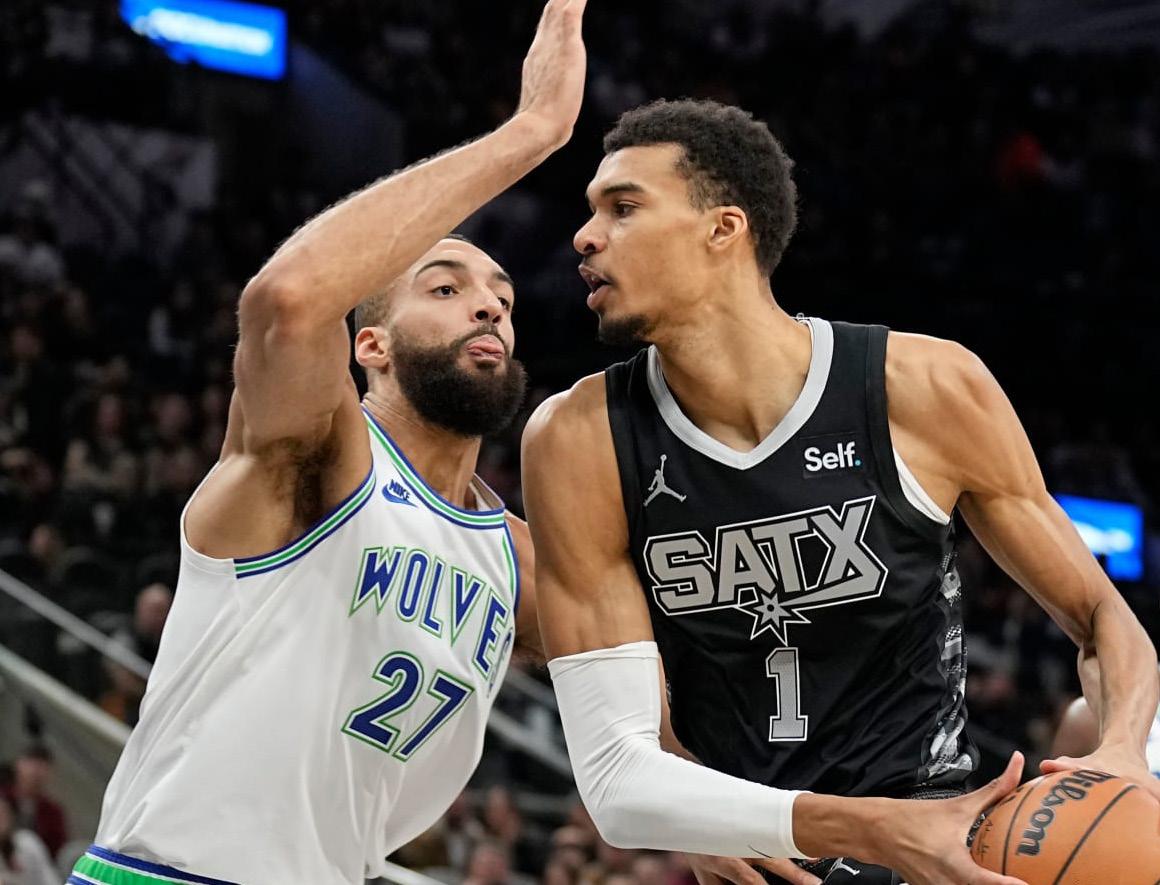
he already has eight games with seven or more blocks, more than Gobert has in his 10+ years of experience. Wembanyama also had significantly better defensive stats (both blocks and steals) than Gobert at the end of the season, giving him the advantage on paper.
Separately, I doubt that a single soul would argue that Gobert is a more interesting player to watch. Wembanyama even has an entire highlight video of NBA stars refusing to shoot against him. Obviously, this doesn’t add to the stat sheet, but it showcases the intimidation
End of season results for spring sports
factor and defensive impact of his presence. It seems that the experts and voters are heavily considering the fact that the Timberwolves as a team performed better than the Spurs. This has caused major controversy as it is the only aspect of basketball where Gobert eclipses Wembanyama. Others have suggested that he is being counted out of the competition for some awards because he is a rookie.
“WEMBY ROBBED BUTTON >>,” said one comment on Instagram, which amassed over 20,000 likes in less than five hours after the
announcement.
These awards are for individual players, not the team. In fact, on May 6, the Timberwolves defensively crushed the reigning champion Denver Nuggets without Gobert, performing better than they did with him. The Timberwolves had the best defensive rating of any NBA team this season, meaning the now four-time Defensive Player of the Year had some more help on his team.
Another case can be found in the Timberwolves’ recent playoff series against the Dallas Mavericks, who tore apart the Minnesota defense and made a fool of Gobert multiple times.
Other award biases beyond this team-based one are common now too, and certainly aren’t specific to the NBA.
Recently, the NFL MVP award has begun to garner negative attention, being deemed “the quarterback award,” as a non-quarterback position player has not won the award in over a decade, and only three have since 2000.
Furthermore, over 60% of the winners since 2000 have been on the team with the best record.
Like with the NBA, this bias is extremely exclusionary to players who are more deserving of the award or may be having historic seasons, which was the case this year in the NFL. It will continually take away from athletes' and players’ individual accomplishments and their importance. It should be the fact that these players stand out that matters, not that their team is successful.
I believe that these award biases come as a result of the perspective that the players are being examined from. Right now they’re placed into context and studied on how much their skills impacted the team, but it’s just too much.
Something needs to be done to remove or reset this bias, or the meaning and importance of league honors will continue to plummet.
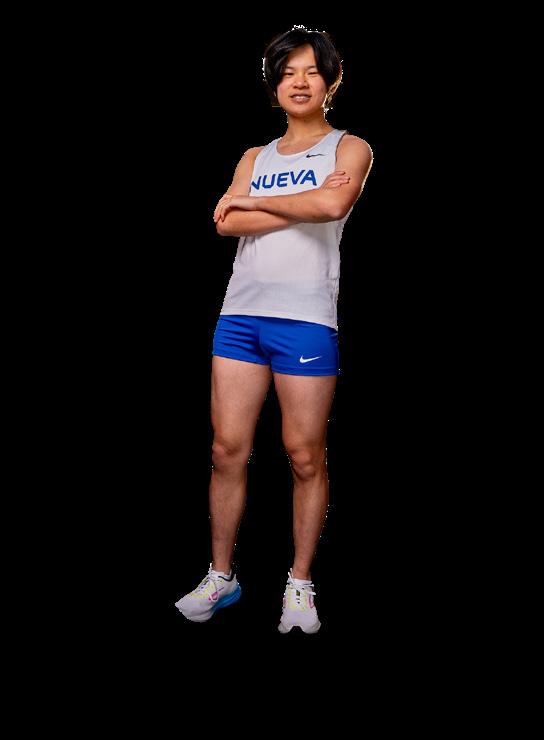

A look at the life of a competitive hocky athlete
By Niam K.Standing on the ice, mere minutes after her Junior Sharks team lost in overtime of the Pacific District finals, Athena C. ’26 took it all in. Just like that, her season was over, heartbreakingly close to making it to Nationals.
Girls ice hockey has been rising in popularity ever since the Professional Women’s Hockey League (PWHL) was founded in August of last year. For Athena and her teammates, the founding of the league shows the progression of their sport and gives them hope for the future.
“I think that the recent start of the Professional Women’s Hockey League is really encouraging for young girls, knowing that there are more opportunities to play past college,” Athena said. “My teammates and I joke that if we had known there would be a professional women’s league, we would have tried way harder.”
Athena doesn’t want her last game to define her season, it was her best season ever, finishing with the third-highest points (goals and assists combined) in California.
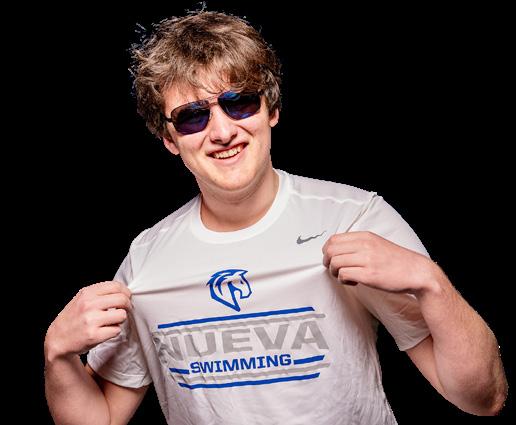
in WBAL with 72 points

6th in WBAL with a record of (3-7) Boys Tennis Boys Swimming 4th in the West Bay Athletic League (WBAL) with 191 points Girls Swimming

To Athena, that accomplishment serves as a testament to her hard work and dedication to the sport she’s played since she was 5.
“It gives me reassurance that I made a strong contribution to my team’s success this year, being a high point producer,” Athena reflected. “My main goal this season was to surpass 50 points because last season I barely missed it with 48, so I was especially happy that I was able to reach that goal.”
Athena’s Junior Sharks are currently ranked 22nd in the nation. This high level of competition means Athena travels across the country weekly to play the best teams in the nation, such as the Anaheim Lady Ducks (25), Florida Alliance (29), and Team Illinois (31). This brings a grueling practice and game schedule, which can make it hard to keep up with her schoolwork.
"It’s definitely a demanding schedule. On the days I have practice I usually don’t get home until past 10 p.m., and then I have to eat, shower, and do homework. I try to do as much work as I can before I leave for practice, and sometimes I have to work in the car as well. But I usually end up napping instead,” Athena recounted.
After 11 years in the sport, hockey has
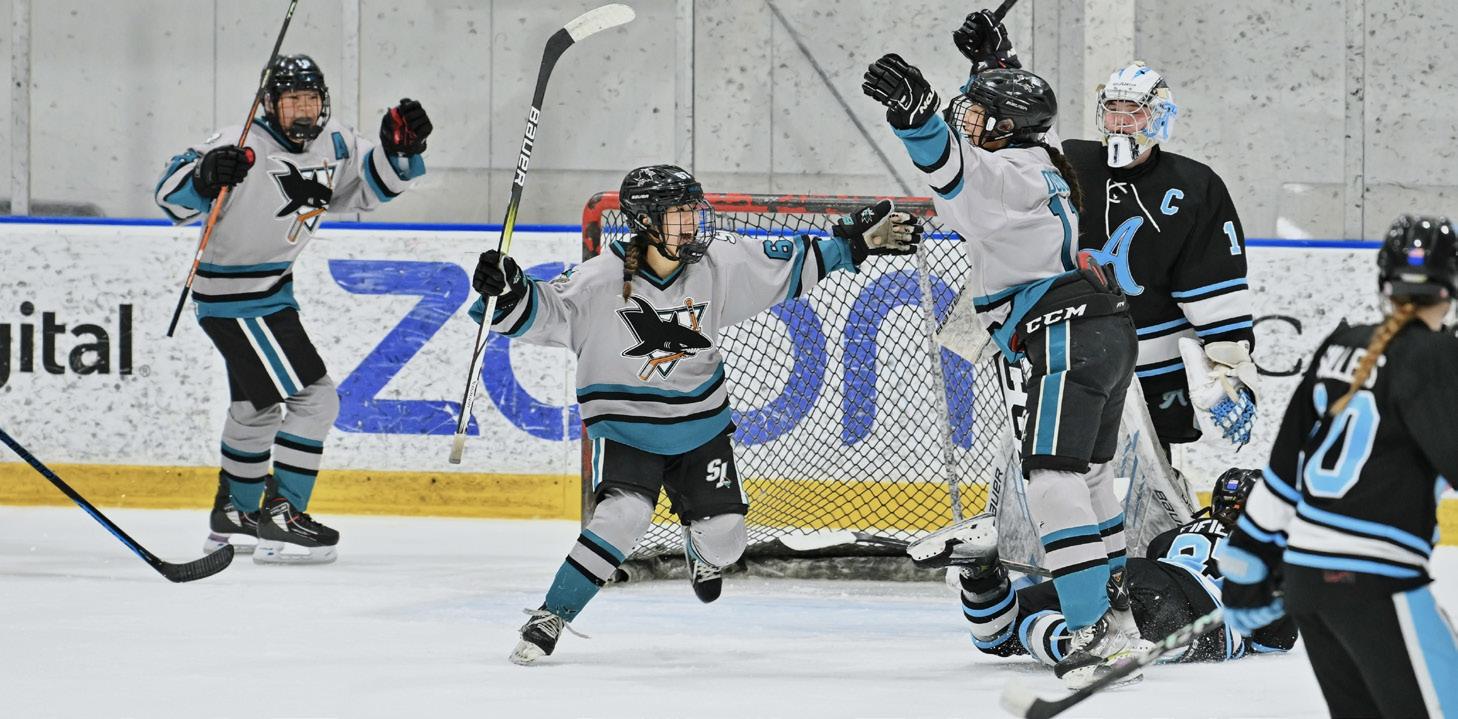
by
become second nature to Athena. She started playing because her older brother, who is currently taking a gap year to play hockey in Minnesota, played and quickly fell in love with the game. Now, the ice is her happy place—the place she can go and have fun no matter what is going on outside of hockey.
“Whenever I step on the ice, I forget about all my problems and am just surrounded by my best friends who also happen to be my teammates,” Athena said. “We have so much fun together and also suffer together when our coach makes us skate suicides.” Athena recently completed tryouts for the national camp and was one of two forwards from the Jr Sharks to be selected for the state camp. She now has the rest of the school year to prepare for her club team tryouts in June.